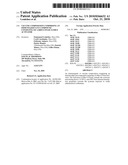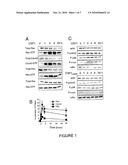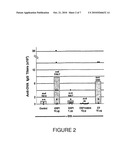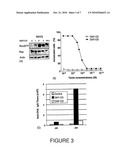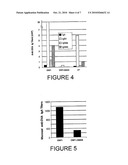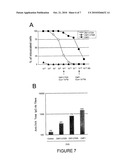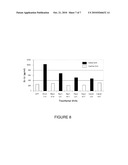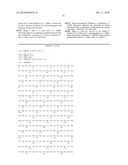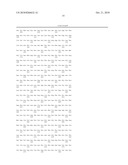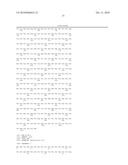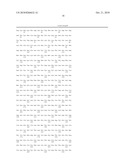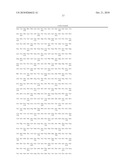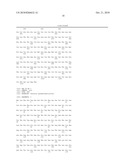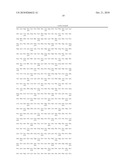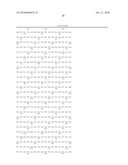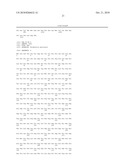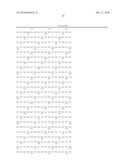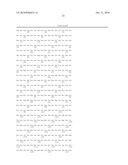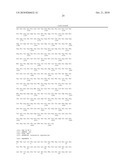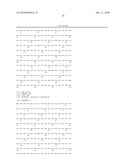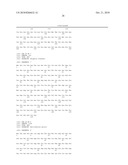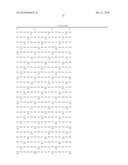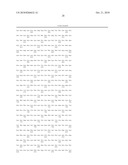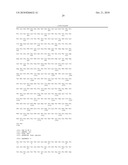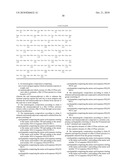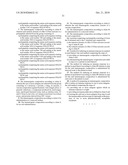Patent application title: VACCINE COMPOSITION COMPRISING AN IMMUNOADJUVANT COMPOUND CONSISTING OF A RHO GTPASE FAMILY ACTIVATOR
Inventors:
Emmanuel Lemichez (Nice, FR)
Cecil Czerkinsky (Nice, FR)
Fabienne Anjuere (Nice, FR)
Patrice Boquet (Villefranche-Sur-Mer, FR)
Patrick Munro (Nice, FR)
Gilles Flatau (Nice, FR)
IPC8 Class: AA61K3939FI
USPC Class:
4242081
Class name: Virus or component thereof retroviridae (e.g., feline leukemia virus, bovine leukemia virus, avian leukosis virus, equine infectious anemia virus, rous sarcoma virus, htlv-i, etc.) immunodeficiency virus (e.g., hiv, etc.)
Publication date: 2010-10-21
Patent application number: 20100266632
Claims:
1. An immunogenic composition comprising:one or more antigens against
which an immune response is sought, andan immunoadjuvant which consists
of a Rho GTPase activator able to maintain a Rho GTPase protein in a form
bound to GTP;wherein the said immunoadjuvant is able to enhance the
immune response against the said one or more antigens and wherein the
said immunoadjuvant is distinct from anyone of the said one or more
antigens.
2. The immunogenic composition according to claim 1 wherein the immunoadjuvant is a Rho GTPase activator which is able to activate a Rho GTPase through a post-translational modification.
3. The immunogenic composition according to claim 1 wherein said immunoadjuvant compound is selected from the group consisting of:a polypeptide comprising the amino acid sequence starting at the amino acid residue 720 and ending at the amino acid residue 1014 of sequence SEQ ID NO:1,a polypeptide comprising the amino acid sequence starting at the amino acid residue 720 and ending at the amino acid residue 1014 of sequence SEQ ID NO:2,a polypeptide comprising the amino acid sequence starting at the amino acid residue 720 and ending at the amino acid residue 1014 of sequence SEQ ID NO:3,a polypeptide comprising the amino acid sequence starting at the amino acid residue 1146 and ending at the amino acid residue 1451 of sequence SEQ ID NO:4,a polypeptide comprising the amino acid sequence SEQ ID NO:5,a polypeptide comprising the amino acid sequence SEQ ID NO:6,a polypeptide comprising the amino acid sequence SEQ ID NO:7,a polypeptide comprising the amino acid sequence SEQ ID NO:8, anda polypeptide comprising the amino acid sequence SEQ ID NO:9.
4. The immunogenic composition according to claim 1 wherein said immunoadjuvant compound is selected from the group consisting of:a polypeptide comprising the amino acid sequence SEQ ID NO:1,a polypeptide comprising the amino acid sequence SEQ ID NO:2,a polypeptide comprising the amino acid sequence SEQ ID NO:3, anda polypeptide comprising the amino acid sequence SEQ ID NO:4.
5. The immunogenic composition according to claim 1, wherein said immunoadjuvant compound is a protein comprising a polypeptide consisting of; from the N-terminal end to the C-terminal end, respectively:a) the injection domain of a Rho GTPase activator, andb) the catalytic domain of a Rho GTPase activator.
6. The immunogenic composition according to claim 5, wherein said injection domain of a Rho GTPase activator is a polypeptide selected from the group consisting of:a polypeptide comprising the amino acid sequence starting at the amino acid residue 1 and ending at the amino acid residue 719 of sequence SEQ ID NO:1;a polypeptide comprising the amino acid sequence starting at the amino acid residue 1 and ending at the amino acid residue 719 of sequence SEQ ID NO:2;a polypeptide comprising the amino acid sequence starting at the amino acid residue 1 and ending at the amino acid residue 719 of sequence SEQ ID NO:3; anda polypeptide comprising the amino acid sequence starting at the amino acid residue 1 and ending at the amino acid residue 1145 of sequence SEQ ID NO:4.
7. The immunogenic composition according to claim 5, wherein said catalytic domain of a Rho GTPase activator is a polypeptide selected from the group consisting of:a polypeptide comprising the amino acid sequence starting at the amino acid residue 720 and ending at the amino acid residue 1014 of sequence SEQ ID NO:1,a polypeptide comprising the amino acid sequence starting at the amino acid residue 720 and ending at the amino acid residue 1014 of sequence SEQ ID NO:2,a polypeptide comprising the amino acid sequence starting at the amino acid residue 720 and ending at the amino acid residue 1014 of sequence SEQ ID NO:3,a polypeptide comprising the amino acid sequence starting at the amino acid residue 1146 and ending at the amino acid residue 1451 of sequence SEQ ID NO:4,a polypeptide comprising the amino acid sequence SEQ ID NO:5,a polypeptide comprising the amino acid sequence SEQ ID NO:6,a polypeptide comprising the amino acid sequence SEQ ID NO:7,a polypeptide comprising the amino acid sequence SEQ ID NO:8, anda polypeptide comprising the amino acid sequence SEQ ID NO:9.
8. The immunogenic composition according to claim 1, wherein the one or more antigens are selected from the group consisting of a hormone, a protein, a drug, an enzyme, a vaccine composition against bacterial, viral, fungal, prion, or parasitic infections, a component produced by microorganisms, inactivated bacterial toxins such as cholera toxin, ST and LT from Escherichia coli, tetanus toxin from Clostridium tetani, and proteins derived from HIV viruses.
9. The immunogenic composition according to claim 1 for administration to a mucosal surface.
10. The immunogenic composition according to claim 1, for an oral administration.
11. The immunogenic composition according to claim 1, wherein the said immunogenic composition consists of a vaccine composition.
12. The immunogenic composition according to claim 11 for administration to a mucosal surface.
13. The immunogenic composition according to claim 11 for oral composition.
14. A protein comprising a polypeptide consisting of; from the N-terminal end to the C-terminal end, respectively:a) the injection domain of a Rho GTPase activator according to claim 5, andb) the catalytic domain of a Rho GTPase activator according to claim 5.
15. A method for inducing an immune response in a patient in need thereof, the said method comprising the steps of:(i) providing an immunogenic composition as defined in claim 1 and(ii) administering the immunogenic composition provided in step (i) to a patient in need thereof.
16. The method for inducing an immune response in a patient in need thereof according to claim 15 wherein in step (ii) the said immunogenic composition is administered by mucosal route to the patient in need.
17. The method for inducing an immune response in a patient in need thereof according to claim 15 wherein in step (ii) the said immunogenic composition is administered by oral route to the patient in need.
18. A method for preparing an immunogenic composition able to induce an immune response to one or more antigens, the said method comprising the steps of:(iv) providing one or more antigens against which an immune response is sought(v) providing an immunoadjuvant as defined in claim 1 and(vi) mixing the said one or more antigens from step (i) and the immunoadjuvant from step (ii) optionally in the presence of one or more pharmaceutically acceptable excipients.
Description:
CROSS REFERENCE TO RELATED APPLICATIONS
[0001]This application is a Continuation-in-Part of copending application Ser. No. 10/589,505 filed on Aug. 15, 2006; which is the 35 U.S.C. 371 national stage of international application PCT/EP2005/002105 filed on Feb. 25, 2005, which claimed priority of EP Application No.: 04300100.7 filed on Feb. 26, 2004. The entire contents of each of the above-identified applications are hereby incorporated by reference.
FIELD OF THE INVENTION
[0002]The present invention relates to a vaccine composition or an immunogenic composition comprising an immuno adjuvant compound, wherein said immuno adjuvant compound consists of a RHO GTPase family activator.
BACKGROUND OF THE INVENTION
[0003]Vaccines have proven to be successful, highly acceptable methods for the prevention of infectious diseases. There are cost effective, and do not induce antibiotic resistance to the target pathogen or affect normal flora present in the host. In many cases, such as when inducing anti-viral immunity, vaccines can prevent a disease for which there are no viable curative or ameliorative treatments available.
[0004]Vaccines function by triggering the immune system to induce a response to an agent, or an antigen, typically in an infectious organism or a portion thereof that is introduced into the body in a non-infectious or non-pathogenic form.
[0005]Once the immune system has been "primed" or sensitised to the organism, later exposure of the immune system to this organism, results in a rapid and robust immune response that destroys the pathogen before it can multiply or infect enough cells in the host organism to cause disease symptoms.
[0006]The agent, or antigen, used to prime the immune system can be the entire organism in a less infectious state, known as an attenuated organism, or in some cases, component of the organism such as carbohydrate proteins or peptides representing various structural components of the organism.
[0007]In many cases, it is necessary to enhance the immune response to the antigens present in a vaccine in order to stimulate the immune system to a sufficient extent to make a vaccine effective, i.e., to confer immunity. Many proteins and most peptide and carbohydrate antigens, administered alone, do not elicit a sufficient antibody response to confer immunity. Such antigens need to be presented to the immune system in such a way that they will be recognized as foreign and will elicit an immune response.
[0008]To this end, additives like adjuvants, have been devised, which immobilise antigens and stimulate the immune response.
[0009]Recombinant proteins are promising vaccine or immunogenic composition candidates because they can be produced at high yield and purity and manipulated to maximize desirable activities and minimize undesirable ones.
[0010]However, because they can be poorly immunogenic, methods to enhance the immune response to recombinant proteins are important in the development of vaccines or immunogenic compositions. Such antigens, especially when recombinantly produced, may elicit a stronger response when administrated in conjunction with an adjuvant.
[0011]The best known adjuvant, Freund's complete adjuvant, consists of a mixture of mycobacteria in an oil/water emulsion.
[0012]Freund's adjuvant works in two ways; first, by enhancing cell and humoral-mediated immunity, and second by blocking rapid dispersal of the antigens challenge, also called "depot effect". However, due to frequent toxic physiological and immunological reactions to this material, Freund's adjuvant cannot be used in humans.
[0013]Another molecule that has been shown to have stimulatory or adjuvant activity is endotoxin, although known as lipopolysaccharide (LPS).
[0014]LPS stimulates the immune system by triggering an immediate immune response, a response that has evolved to enable an organism to recognize endotoxin and the invading bacteria (of which it is a component) without the need for the organism to have been previously exposed. But LPS is although too toxic to be a viable adjuvant.
[0015]Thus, there is a recognized and permanent need in the art for new compounds which can be administered with antigens in order to stimulate the immune system and generate a more robust antibody response to the antigen than will be seen if the antigens were injected alone.
[0016]Additionally, it should be noted that parenteral administration i.e. intramuscularly or sub-cutaneous, of antigens of vaccines are normally regarded as the most convenient way of administration.
[0017]However, the injection presents a range of disadvantages. It requires the use of sterile syringes and may cause pains and irritations, particularly in the case of repeated injections, including the risk of infection. More significantly, intramuscularly injections are often poorly tolerated. There is often likely to be indurations (hardening of tissue) haemorrhages and/or necrosis (local death of tissue) at the injection site. Besides, untrained person cannot administer injections.
[0018]Based on these observations, it should be noted that mucosal immunity has take a considerable importance in vaccine development because nearly all viral, bacterial and parasitic agent that cause disease of the intestinal, respiratory and genital tracks enter through the mucosal barrier. Furthermore, mucosal and systemic immune responses are often elicited and regulated independently, and induction of protective immunity at the most frequent sites of entry is likely to be most effective. Additionally, young children and elderly individuals may respond better to mucosal vaccines because the mucosal immune system develops earlier and appears to remain functional longer than the systemic compartment. Mucosal immunisations are also easier and less expensive than systemic immunisations. For example, the existence of an oral polio vaccine has allowed immunisation campaigns that may soon eradicate polio worldwide.
[0019]Accordingly, it is also an object of the present invention to provide a vaccine composition comprising an immunoadjuvant compound which could be administered by the mucosal route. These and further objects will be apparent to one ordinary skill in the art.
SUMMARY OF THE INVENTION
[0020]The present invention is based on the experimental findings that an activator of Rho GTPases, namely the cytotoxic necrotizing factor 1 (cnf1) bears immunostimulatory properties towards the systemic and mucosal responses to orally administered ovalbumine, a prototype soluble protein antigen. CNF1 consists of an injection domain (amino acid residues 1-719 of SEQ ID NO:1), allowing the binding and endosomal penetration of the toxin, followed by the intracytoplasmic injection of its catalytic domain (amino acid residues 720-1014 of SEQ ID NO:1), responsible for Rho GTPases protein family activation.
[0021]A first object of the invention consists in a vaccine or an immunogenic composition comprising an immunoadjuvant compound, wherein said immunoadjuvant compound consists of a Rho GTPase activator.
[0022]More precisely, the present invention relates to an immunogenic composition comprising: [0023]one or more antigens against which an immune response is sought, and [0024]an immunoadjuvant which consists of a Rho GTPase activator which is able to maintain a Rho GTPase protein in a form bound to GTP;wherein the said immunoadjuvant is able to enhance the immune response against the said one or more antigens and wherein the said immunoadjuvant is distinct from anyone of the said one or more antigens.
[0025]In some embodiments, the said immunogenic composition consists of a vaccine composition.
[0026]In another aspect, the invention relates to a vaccine or an immunogenic composition wherein said immunoadjuvant compound is selected from the group consisting of: [0027]a polypeptide comprising the amino acid sequence starting at the amino acid residue 720 and ending at the amino acid residue 1014 of sequence SEQ ID NO:1, [0028]a polypeptide comprising the amino acid sequence starting at the amino acid residue 720 and ending at the amino acid residue 1014 of sequence SEQ ID NO:2, [0029]a polypeptide comprising the amino acid sequence starting at the amino acid residue 720 and ending at the amino acid residue 1014 of sequence SEQ ID NO:3, [0030]a polypeptide comprising the amino acid sequence starting at the amino acid residue 1146 and ending at the amino acid residue 1451 of sequence SEQ ID NO:4, [0031]a polypeptide comprising the amino acid sequence SEQ ID NO:5, [0032]a polypeptide comprising the amino acid sequence SEQ ID NO:6, [0033]a polypeptide comprising the amino acid sequence SEQ ID NO:7, [0034]a polypeptide comprising the amino acid sequence SEQ ID NO:8, and [0035]a polypeptide comprising the amino acid sequence SEQ ID NO:9.
[0036]The present invention also relates to a vaccine or an immunogenic composition wherein the immunoadjuvant compound is a protein comprising a polypeptide consisting of; from the N-terminal end to the C-terminal end, respectively: [0037]a) the injection domain of a Rho GTPase activator, and [0038]b) the catalytic domain of a Rho GTPase activator.Another object of the invention is a method for inducing an immune response in a patient in need, the said method comprising the steps of: [0039](i) providing an immunogenic composition as above-defined [0040](ii) administering the immunogenic composition provided in step (i) to a patient in need thereofA further object of the invention is a method for preparing an immunogenic composition able to induce an immune response to one or more antigens, the said method comprising: [0041](i) providing one or more antigens against which an immune response is sought [0042](ii) providing an immunoadjuvant as above-defined and [0043](iii) mixing the said one or more antigens from step (i) and the said immunoadjuvant from step (ii) optionally in the presence of one or more pharmaceutically acceptable excipients
DESCRIPTION OF DRAWINGS
[0044]FIG. 1: CNF1 Effects on Cell Signaling Pathway.
[0045]1A: Immunoblots showing the kinetics of CNF1-induced activation of Rho, Rac and Cdc42 in contrast to Ras, in HUVEC. Cells were treated with 10-9M CNF1 for different periods of time. Cell lysates were subjected to GST-fusion protein pull-down assays (noted GTPases-GTP). In parallel, 2% of each cell lysate were processed for immunoblotting to monitor their cellular depletion (noted Total-GTPases).
[0046]1B: Quantification of the CNF1-induced Rho protein activation. Immunoblots were scanned and quantified using N.I.H. Image 1.6. The level of activated Rho proteins was compared to the total Rho GTPase level present in 2% of control cell lysates (mean value of three independent experiments±SD).
[0047]1C: Immunoblots showing the interference of native CNF1 and catalytic inactive CNF1-C866S on cell signaling. HUVEC were treated with "10-9M" CNF1 or CNF1-C866S for the indicated periods of time, prior to immunoblotting analysis. MAP kinase signaling was investigated using anti-phosphop44/42 MAP Kinase (noted P-p44/42) and anti-phospho-p38 MAP Kinase (noted P-p38) antibodies. Jun kinase activity was investigated by anti-phospho-c-jun (noted P-c-jun) immunoblotting. NF-kappaB signaling pathway activation was investigated by following the IkBα cellular depletion on immunoblots.
[0048]FIG. 2: Catalytic Active CNF1 Stimulates Serum IgG Responses to Orally Administered Ovalbumin (OVA).
[0049]Five groups of mice were fed OVA alone (control) or co-administered with either CNF1 (1 or 10 μg) or CNF1-C866S (10 μg) or CT (10 μg). Groups of eight mice were immunized with CNF1 or CNF1-C866S, whereas groups of four mice were immunized with OVA alone or OVA+CT. Groups of mice were challenged once, 2 weeks after the first immunization and sera collected 30 days after the first immunization. Levels of the seric anti-OVA IgG titers are expressed as geometric means (histogram and mean values) of the total IgG titers. These results are representative of two independent experiments. Anti-OVA IgG titers from individual animals are displayed (•).
[0050]FIG. 3: DNT Catalytic Domain Stimulates Serum IgG Responses to Orally Administered Ovalbumin (OVA).
[0051]3A: Immunoblots showing the kinetics of DNT-Cdinduced activation and cellular depletion of Rac. 804G cells were treated with 100 μg of DNT-CD and processed for activated Rac measurements by GST-Pak pull-down (noted RacGTP). Immunoblotting of 10 μg of total lysate was performed to visualize DNT-CD induced Rac depletion (noted Rac) and equal quantities of proteins engaged in the GST pull-down (actin).
[0052]3B: Comparison of the cellular activities of CNF-CD and DNT-CD. The graph illustrates the percentage of HEp-2 multinucleated cells measured 48 h following intoxication by different concentrations of either CNF-CD or DNT-CD.
[0053]3C: Serum IgG responses to orally administered ovalbumin (OVA). Three groups of 4 mice were fed with OVA alone (control) or co-administered with either CNF-CD (100 μg) or DNT-CD (100 μg). Groups of mice were challenged twice, 2 and 5 weeks after the first immunization and sera collected 30 and 60 days after the first immunization. Levels of the seric anti-OVA IgG titers are expressed as geometric means of the total IgG titers.
[0054]FIG. 4: CNF1, CNF1-C866S and CT Induction of Anti-OVA Ig Subclasses.
[0055]Three groups of three mice were challenged twice after the first immunization and sera collected 45 days after the first immunization. Levels of the anti-OVA Ig subclasses are expressed as geometric means (histogram).
[0056]FIG. 5: CNF1 Induction of Mucosal Anti-OVA IgA Response.
[0057]Two groups of three mice were challenged twice, after the first immunization, with OVA supplemented with 10 μg of either CNF1 or CNF1-C866S. Mice were processed according to the PERFEXT method (see the section Material and Method). Levels of the anti-OVA IgA responses are expressed as geometric means (histogram).
[0058]FIG. 6: Histology of Small Intestines of Mice Fed CNF1 or CNF1-C866S as Compared to Control Untreated Mice.
[0059]Shown are paraffin sections stained with haematoxylin and eosin.
[0060]FIG. 7: Measure of the Immunoadjuvant Properties and Toxin Activity of CNF1 and DNT.
[0061]7A: Measure of the toxin activity of CNF1, CNF1-CTER (720-1014), DNT-CTER (1154-1451) estimated by HEp-2 cells multinucleation assay, as previously described (Lemichez et al., 1997). As previously reported, CNF1-CTER is poorly active on cells due to its inability to penetrate into the cytosol (Lemichez et al., 1997). DNT-CTER shows a one thousand lower activity, as compared to CNF1.
[0062]7B: Serum IgG antibody responses to orally co-administered ovalbumin (OVA) and DNT or CNF1-toxin catalytic domains. Groups of 4 mice were fed OVA alone or co-administered with either CNF1-CTER (720-1014) (100 μg) or DNT-CTER (1154-1451) (100 μg). For CNF1, a group of height mice were fed OVA and CNF1 (10 μg). Mice were challenged once, two weeks after the first immunization and sera collected 30 days after the first immunization. Data are expressed as geometric mean serum IgG anti-OVA Ab titers.
[0063]FIG. 8: Secretion of IL-1β by THP1 Cells Transfected with a DNA Construct Encoding for a Constitutively Activated Rho GTPase or an Inactive Rho GTPase.
[0064]The expression of an active form of a Rho GTPase in THP1 cell line induces a significant increase of the secretion of IL-1β. In the case of the expression of an inactive Rho GTPase, the level of IL-1β secretion remains unchanged as compared to control cells (THP1 cells transfected with a construct encoding for GFP).
[0065]X-coordinate: Rho GTPase encoded by the construct transfected in THP1 cells. RhoA V14, Rac1 L61, Rac2 L61 and Cdc42 L61: activated Rho GTPase mutants. RhoA N19, Rac1 N17, Rac2 N17 and Cdc42 N17: inactive Rho GTPase mutants.
[0066]Y-coordinate: concentration of IL-1β in the supernatants of transfected THP1 cells.
DETAILED DESCRIPTION OF THE INVENTION
[0067]The inventors have found according to the invention that Rho GTPase activators bear immunoadjuvant properties in vivo, when co-administered with an antigen, like ovalbumin.
[0068]Rho proteins are essential regulatory molecules controlling the actin cytoskeleton organisation and dynamics to accomplish different tasks such as cell polarity, movement, differentiation and phagocytosis (Takai et al., 2001, Etienne-Manneville et al., 2002, Chimini and Chavrier, (2000)). Importance of Rho proteins in physiology is also evidenced by their direct or indirect implication as part of signaling molecules found mutated in human genetic disorders, as well as targets of numerous bacterial virulence factors and toxins (Boettner and Van Aelst, (2002) Boquet and Lemichez, (2003).
[0069]Rho proteins interfere with a large variety of signaling pathways controlling gene transcription (Bishop et al., 2000). Among them, a recent report has evidenced the activation of Rac and Cdc42 downstream the Toll-like receptor 2, a gram positive pathogen molecular pattern recognition receptor (PAMP) (Arbibe et al. (2000), Medzhitov et al. (2002).
[0070]Also exemplifying the inter-relation between Rho proteins and the host defences is the Rac, Cdc42, VAV and WASP formation of a supra-molecular activation complex (SMAC or "immunological synapse" crucial for lymphocyte activation (Krawczyk et al. 2001).
[0071]Many different pathogenic bacteria have evolved virulence factors and toxins aimed at mimicking an activation of Rho GTPase protein family, naturally occurring in eukaryotic cells via specific regulators namely GEF (for guanine nucleotide exchange factors). These cellular GEF consist in domains comprised in large proteins as best described for Dbl (Olson et al., 1996; Schmidt and Hall 2002). Despite their lack of sequence homologies, virulence factors of pathogenic bacteria, for instance SopE and SopE2 from Salmonella have a GEF-like activity (Galan et al., 2000). Some other known factors of pathogenic bacteria, namely IpaC from Shigella and CagA from Helicobacter, activate Rho GTPases by yet uncharacterised molecular mechanisms (Tran Van Nhieu et al., 2000; Boquet and Lemichez 2003). Finally, a group of bacterial toxins comprising CNF1, CNF2, CNFY and DNT also activates Rho proteins through a post-traductional modification (also called post-translational modification). The catalytic sites of these proteins are closely related since the catalytic site of CNF1 (CNF1-CD) is 84% identical to that of CNF2 (CNF2-CD), and 22% identical to that of DNT (DNT-CD) (Boquet and Lemichez 2003).
[0072]According to the invention, the inventors have now surprisingly found that the cytotoxic necrotising factor 1 (CNF1) has immunoadjuvant properties. More precisely, the inventors have found that CNF1 bears immunostimulatory properties toward the systemic and mucosal responses to orally administrated ovalbumin in mice.
[0073]Additionally, the inventors have found that a mutant of CNF1, namely CNF1-C866S, a catalytically inactive mutant of CNF1 toward GTPases, in contrast to the wild type toxin, does not stimulate the systemic and mucosal responses to ovalbumin. This result points for Rho GTPases proteins activation being directly involved in the immunostimulatory effects of CNF1.
[0074]Supporting this point, the inventors have also found according to the invention that the catalytic domain of CNF1, and the catalytic domain of DNT, another Rho GTPase activator, bear also immunoadjuvant properties in vivo, when co-administered with an antigen, like ovalbumin.
[0075]The inventors have also shown in vitro that the expression of a constitutively activated Rho GTPase in the THP1 cell line (Human acute monocytic leukemia cell line) induces a significant increase of the secretion of IL1-β which is known to be an effective mucosal and systemic immunoadjuvant. Such an induction of IL-1β is not observed when THP1 cells are transfected with a construct encoding an inactivated Rho GTPase.
[0076]Taken together, these results clearly demonstrate that various Rho GTPases activators, structurally distinct, one from the others, have immunoadjuvant properties which result from their functional feature (i.e. their ability to activate Rho GTPase). The said immunoadjuvant properties are thus independent from their structural features. Without wishing to be bound by any theory, the inventors believe that the main mechanism underlying the immunoadjuvant properties of Rho GTPase activators consists of the induction of the IL1-β subsequently to Rho GTPase activation.
[0077]Further, a scientific article (Muller, 2009), published after the filing date of application Ser. No. 10/859,505 (called parent application hereafter) from which the present application is a continuation-in-part application, has corroborated the results shown by the inventors. Muller et al. have confirmed that SOPE-2, a Rho GTPase activator described as an immunoadjuvant in the parent application, triggers mucosal inflammation in vivo through the caspase-1 activation-dependent release of mature IL-1β. Muller et al. have also confirmed in vitro that this mechanism is dependent of the activation of Rho GTPases by SOPE-2.
[0078]Furthermore, the inventors have found that non neutralizing anti-CNF1 antibodies are naturally found in humans, and that CNF1 activates the Rho GTPase proteins only transiently. Taken together these results demonstrate that CNF1 can be used as an immunoadjuvant compound, deserved of adverse effects such as the toxic effects described for LPS or Cholera Toxin B.
[0079]Accordingly, a first object of the invention consists in a vaccine or an immunogenic composition comprising an immunoadjuvant compound, wherein said immunoadjuvant compound consists of a Rho GTPase activator.
[0080]By "immunoadjuvant" it is herein intended a substance enhancing the immunogenicity of an antigen.
[0081]By "Rho GTPase activator" it is intended herein a compound, which maintains Rho GTPases in a form bound to GTP. In other words, "Rho GTPase activator" encompasses polypeptides which exhibit Rho GTPase-activation ability. It is self-evident that "Rho GTPase activator" does not include proteins derived from Rho GTPase activator which are unable to activate Rho GTPases.
[0082]In other words, proteins resulting from the chemical/physical treatment or from the genetic alteration of a Rho GTPase activator are excluded from the scope of the present invention if the said genetic alteration or the said chemical/physical treatment leads to the loss of the GTPase-activation ability. For example, CNF1-C866S is not a "Rho GTPase activator" as defined herein since the said protein fails to activate Rho GTPases. Similarly, toxoids resulting from the heat treatment or the chemical treatment (such as formalin) of Rho GTPase activators do not belong to the group of Rho GTPase activators, as defined herein.
[0083]By "Rho GTPases", the one skilled in the art will understand the proteins belonging to the Rho GTPase family, which encompasses RhoA, RhoB, RhoC, Rac1, Rac2 and Cdc42. (Burridge and Wennerberg, 2004).
[0084]The level of Rho GTPase bound to GTP can be easily measured by the methods, referred by those skilled in the art as GST-pull down assays and described for RhoA, B and C by Ren et al., 1999 and for Rac1, Rac2 and Cdc42 by Manser et al., 1998. These methods are described in the section Materials and methods.
[0085]Accordingly, in a preferred embodiment, the vaccine or the immunogenic composition comprises an immunoadjuvant which consists of a Rho GTPase activator which is able to maintain a Rho GTPase protein in a form bound to GTP
[0086]In some embodiments, the vaccine or the immunogenic composition, as defined above, comprises an immunoadjuvant consisting of a Rho GTPase activator which is able to activate a Rho GTPase through a post-translational modification.
[0087]Examples of such Rho GTPase activators are proteins belonging to the bacterial toxin group comprising CNF1, CNF2, CNFY and DNT
[0088]In other embodiments, the invention also concerns a vaccine or an immunogenic composition, wherein said immunoadjuvant is selected from the group consisting of: [0089]a polypeptide comprising the amino acid sequence starting at the amino acid residue 720 and ending at the amino acid residue 1014 of sequence SEQ ID NO:1, [0090]a polypeptide comprising the amino acid sequence starting at the amino acid residue 720 and ending at the amino acid residue 1014 of sequence SEQ ID NO:2, [0091]a polypeptide comprising the amino acid sequence starting at the amino acid residue 720 and ending at the amino acid residue 1014 of sequence SEQ ID NO:3, [0092]a polypeptide comprising the amino acid sequence starting at the amino acid residue 1146 and ending at the amino acid residue 1451 of sequence SEQ ID NO:4, [0093]a polypeptide comprising the amino acid sequence SEQ ID NO:5, [0094]a polypeptide comprising the amino acid sequence SEQ ID NO:6, [0095]a polypeptide comprising the amino acid sequence SEQ ID NO:7, [0096]a polypeptide comprising the amino acid sequence SEQ ID NO:8, and [0097]a polypeptide comprising the amino acid sequence SEQ ID NO:9.
[0098]A Rho GTPase activator encompasses peptides comprising the amino acid sequence of interest starting at the amino acid residue 720 and ending at the amino acid residue 1014 of sequence SEQ ID NO:1 described above, and comprising a N-terminal amino acid sequence, linked to the amino group of the residue 720 of sequence SEQ ID NO:1.
[0099]Preferably, the N-terminal amino acid sequence has a length up to 800 amino acid residues.
[0100]Preferably, the N-terminal amino acid sequence is homologous to a part or to the full length amino acid sequence starting at the amino acid residue 1 and ending at the amino acid residue 719 of CNF1 of SEQ ID NO:1.
[0101]In such a case, the N-terminal amino acid sequence can comprise substitutions of non-essential amino acid comprised in the sequence starting at the amino acid residue 1 and ending at the amino acid residue 719 of CNF1 of SEQ ID NO:1.
[0102]A "non essential" amino acid residue is an amino acid residue that can be altered from the wild type sequence of CNF1 without altering the activating properties of Rho GTPases, whereas an "essential" amino acid residue is required for biological activity.
[0103]A Rho GTPase activator encompasses also peptides comprising two or more repeated motifs of the sequence 720-1014 of interest. In such a case, said peptide can comprise also an N-Terminal sequence as defined above.
[0104]A Rho GTPase activator encompasses also peptides structurally similar to those described above, derived from the catalytic domain of CNF2 of sequence SEQ ID NO:2, the catalytic domain of CNF of sequence SEQ ID NO:3 and the catalytic domain of DNT of sequence SEQ ID NO:4.
[0105]The use of the catalytic domain of Rho GTPase activator, as described above, is of particular interest. Indeed, as demonstrated in example 6, in the case of CNF1, and DNT, the use of the catalytic domain of these proteins is less toxic for cells than the overall proteins, but is sufficient to confer immunoadjuvanticity.
[0106]A Rho GTPase activator encompasses also peptides comprising: [0107]the amino acid sequence SEQ ID NO:5 corresponding to SOPE, or [0108]the amino acid sequence SEQ ID NO:6 corresponding to SOPE2, or [0109]The amino acid sequence SEQ ID NO:7 corresponding to IpaC, or [0110]the amino acid sequence SEQ ID NO:8 corresponding to CagA, or [0111]the amino acid sequence SEQ ID NO:9 corresponding to the GEF sequence of Dbl,which include more amino acids, and exhibit at least the same activity towards Rho GTPase activation.
[0112]Alternatively, the immunoadjuvant according to the invention is selected from the group consisting of: [0113]a polypeptide comprising the amino acid sequence SEQ ID NO:1, [0114]a polypeptide comprising the amino acid sequence SEQ ID NO:2, [0115]a polypeptide comprising the amino acid sequence SEQ ID NO:3, and [0116]a polypeptide comprising the amino acid sequence SEQ ID NO:4.
[0117]Another object of the invention consists in a vaccine composition, wherein said immunoadjuvant compound is a protein comprising a polypeptide consisting of; from the N-terminal end to the C-terminal end, respectively: [0118]a) the injection domain of a Rho GTPase activator, and [0119]b) the catalytic domain of a Rho GTPase activator.
[0120]By "injection domain of a Rho GTPase activator" it is intended herein, an amino acid sequence allowing the binding and intracellular penetration of a catalytic domain of a Rho GTPase activator.
[0121]By "catalytic domain of a Rho GTPase activator" it is intended herein, an amino acid sequence able to activate a Rho GTPase.
[0122]The attachment of the injection domain to the catalytic domain above mentioned, to produce a fusion protein may be effected by any means which produces a link between the two constituents, which is sufficiently stable to withstand the conditions used and which does not alter the function of either constituent.
[0123]Preferably, the link between them is covalent.
[0124]Numerous chemical cross-linking methods are known and potentially applicable for producing the fusion protein. For example, non-specific chemical cross-linking methods, or preferably methods of direct chemical coupling to a functional group, found only once or a few times in one or both of the polypeptides to be cross-linked.
[0125]Coupling of the two constituents can also be accomplished via a coupling or conjugating agent. There are several intermolecular cross-linking reagents, which can be used (see, for example, Means, G. E. et al. (1974)). Among these reagents are, for example, N-succinimidyl 3-(2-pyridyldithio) propionate (SPDP) or N,N'-(1,3-phenylene) bismaleimide.
[0126]Cross-linking reagents may be homobifunctional, i.e., having two functional groups that undergo the same reaction such as bismaleimidohexane ("BMH").
[0127]Alternatively, to solve the problems of protein denaturation and contamination during chemical conjugation, recombinant techniques can be used to covalently attach the polypeptide of interest to the virulence factor, such as by joining the nucleic acid coding for the polypeptide of interest with the nucleic acid sequence coding for the virulence factor and introducing the resulting gene construct into a cell capable of expressing the conjugate.
[0128]Recombinant methodologies required to produce a DNA encoding a desired protein are well known and routinely practiced in the art. Laboratory manuals, for example MOLECULAR CLONING: A LABORATORY MANUAL. Cold Spring Harbor Press: Cold Spring Harbor, N.Y. (1989) describes in detail techniques necessary to carry out the required DNA manipulations.
[0129]The fusion protein can be produced in recombinant microorganism transformed therewith. In this process, each protein component is preferably linked in the molecular ratio of 1:1 (injection domain: catalytic domain). The aid of an appropriate linker, in order to allow proper folding of each protein molecule can be useful. As a linker, it is preferable to use a peptide consisting of the appropriate number of amino acids to maintain activity of each protein component, such as, a peptide composed of 0 to 20 amino acids, though glycine, (glycine)4 serine, or [(glycine)4 serine]2.
[0130]Preferable vectors include any of the well known prokaryotic expression vectors, recombinant baculoviruses, COS cell specific vectors, or yeast-specific expression constructs.
[0131]Alternatively, the two separate nucleotide sequences can be expressed in a cell or can be synthesized chemically and subsequently joined, using known techniques. Alternatively, the fusion protein can be synthesized chemically as a single amino acid sequence (i.e., one in which both constituents are present) and, thus, joining is not needed.
[0132]Preferably, the injection domain of a Rho GTPase activator is a polypeptide selected from the group consisting of: [0133]a polypeptide comprising the amino acid sequence starting at the amino acid residue 1 and ending at the amino acid residue 719 of sequence SEQ ID NO:1; [0134]a polypeptide comprising the amino acid sequence starting at the amino acid residue 1 and ending at the amino acid residue 719 of sequence SEQ ID NO:2; [0135]a polypeptide comprising the amino acid sequence starting at the amino acid residue 1 and ending at the amino acid residue 719 of sequence SEQ ID NO:3; and [0136]a polypeptide comprising the amino acid sequence starting at the amino acid residue 1 and ending at the amino acid residue 1145 of sequence SEQ ID NO:4.
[0137]Preferably, the catalytic domain of a Rho GTPase activator is a polypeptide selected from the group consisting of: [0138]a polypeptide comprising the amino acid sequence starting at the amino acid residue 720 and ending at the amino acid residue 1014 of sequence SEQ ID NO:1, [0139]a polypeptide comprising the amino acid sequence starting at the amino acid residue 720 and ending at the amino acid residue 1014 of sequence SEQ ID NO:2, [0140]a polypeptide comprising the amino acid sequence starting at the amino acid residue 720 and ending at the amino acid residue 1014 of sequence SEQ ID NO:3, [0141]a polypeptide comprising the amino acid sequence starting at the amino acid residue 1146 and ending at the amino acid residue 1451 of sequence SEQ ID NO:4, [0142]a polypeptide comprising the amino acid sequence SEQ ID NO:5, [0143]a polypeptide comprising the amino acid sequence SEQ ID NO:6, [0144]a polypeptide comprising the amino acid sequence SEQ ID NO:7, [0145]a polypeptide comprising the amino acid sequence SEQ ID NO:8, and [0146]a polypeptide comprising the amino acid sequence SEQ ID NO:9.
[0147]The invention also concerns the vaccine or an immunogenic composition as described above, further comprising one or more antigens against which an immune response is sought.
[0148]Indeed, the immunoadjuvant according to the present shall enhance the immune response against the said or more antigens. It goes without saying that the immunoadjuvant is distinct from anyone of said one or more antigens against which the said immune response is sought. Accordingly, in a preferred embodiment, the immunogenic composition or the vaccine composition comprises: [0149]one or more antigens against which an immune response is sought, and [0150]an immunoadjuvant which consists of a Rho GTPase activator able to maintain a Rho GTPase protein in a form bound to GTP;wherein the said immunoadjuvant is able to enhance the immune response against the said one or more antigens and wherein the said immunoadjuvant is distinct from anyone of the said one or more antigens.
[0151]As illustrated in the following examples, when co-administered with an antigen, an immunoadjuvant as defined in the present invention enhances the humoral response to said antigen.
[0152]In some embodiment, the immunoadjuvant is able to enhance the humoral immune response against the one or more antigens comprised in the vaccine or the immunogenic composition.
[0153]Preferably, the one or more antigens are selected from the group consisting of a hormone, a protein, a drug, an enzyme, a vaccine composition against bacterial, viral, fungal, prion, or parasitic infections, a component produced by microorganisms, inactivated bacterial toxins such as cholera toxin, ST and LT from Escherichia coli, tetanus toxin from Clostridium tetani, and proteins derived from HIV viruses.
[0154]As described above, the one or more antigens are distinct from the Rho GTPase activator used as immunoadjuvant in the vaccine or immunogenic composition.
[0155]In some embodiments, the one or more antigens do not comprise the amino acid sequence starting at the amino acid residue 720 and ending at the amino acid residue 1014 of sequence SEQ ID NO:1.
[0156]In some embodiments, the one or more antigens do not comprise the amino acid sequence starting at the amino acid residue 720 and ending at the amino acid residue 1014 of sequence SEQ ID NO:2.
[0157]In some embodiments, the one or more antigens do not comprise the amino acid sequence starting at the amino acid residue 720 and ending at the amino acid residue 1014 of sequence SEQ ID NO:3.
[0158]In some embodiments, the one or more antigens do not comprise the amino acid sequence starting at the amino acid residue 1146 and ending at the amino acid residue 1451 of sequence SEQ ID NO:4.
[0159]In some embodiments, the one or more antigens do not comprise the amino acid sequence SEQ ID NO:5.
[0160]In some embodiments, none of the one or more antigens comprises comprising the amino acid sequence SEQ ID NO:6.
[0161]In some embodiments, the one or more antigens do not comprise the amino acid sequence SEQ ID NO:7.
[0162]In some embodiments, the one or more antigens do not comprise the amino acid sequence SEQ ID NO:8.
[0163]In some embodiments, none of the one or more antigens comprises comprising the amino acid sequence SEQ ID NO:9.
[0164]In some embodiments, the one or more antigens are not antigens from Escherichia coli strains.
[0165]In some embodiments, the one or more antigens are not antigens from Bordetella pertussis strains. In some embodiments, the one or more antigens are not antigens from Yersinia pseudotuberculosis strains.
[0166]In some embodiments, the one or more antigens are not antigens from Salmonella typhimurium strains.
[0167]In some embodiments, the one or more antigens are not antigens from Shigella flexneri strains
[0168]In some embodiments, the one or more antigens are not antigens from Helicobacter pylori strains
[0169]The amount of antigen, and immunoadjuvant compound in the vaccine composition according to the invention, the dosages administered, are determined by techniques well known to those skilled in the pharmaceutical art, taking into consideration such factors as the particular antigen, the age, sex, weight, species, and condition of the particular animal or patient, and the route of administration.
[0170]In a preferred embodiment, the vaccine or immunogenic composition according to the invention, further comprises one or more pharmaceutically acceptable components or excipients, or solid or liquid carriers.
[0171]Some of these components or excipients may be selected from the group consisting of surfactants, absorption promoters, water absorbing polymers, substances which inhibit enzymatic degradation, alcohols, organic solvents, oils, pH controlling agents, preservatives, osmotic pressure controlling agents, propellants, water and mixture thereof.
[0172]The vaccine or immunogenic composition according to the invention can further comprise a pharmaceutically acceptable carrier. The amount of the carrier will depend upon the amounts selected for the other ingredients, the desired concentration of the antigen, the selection of the administration route, oral or parenteral, etc. The carrier can be added to the vaccine at any convenient time. In the case of a lyophilised vaccine, the carrier can, for example, be added immediately prior to administration. Alternatively, the final product can be manufactured with the carrier.
[0173]Examples of appropriate carriers include, but are not limited to, sterile water, saline, buffers, phosphate-buffered saline, buffered sodium chloride, vegetable oils, Minimum Essential Medium (MEM), MEM with HEPES buffer, etc.
[0174]Optionally, the vaccine or immunogenic composition of the invention may contain conventional, secondary adjuvants in varying amounts depending on the adjuvant and the desired result. The customary amount ranges from about 0.02% to about 20% by weight, depending upon the other ingredients and desired effect.
[0175]Examples of suitable secondary adjuvants include, but are not limited to, stabilizers; emulsifiers; aluminum hydroxide; aluminum phosphate; pH adjusters such as sodium hydroxide, hydrochloric acid, etc.; surfactants such as Tween.®. 80 (polysorbate 80, commercially available from Sigma Chemical Co., St. Louis, Mo.); liposomes; iscom adjuvant; synthetic glycopeptides such as muramyl dipeptides; extenders such as dextran or dextran combinations, for example, with aluminum phosphate; carboxypolymethylene; bacterial cell walls such as mycobacterial cell wall extract; their derivatives such as Corynebacterium parvum; Propionibacterium acne; Mycobacterium bovis, for example, Bovine Calmette Guerin (BCG); vaccinia or animal poxvirus proteins; subviral particle adjuvants such as orbivirus; cholera toxin; N,N-dioctadecyl-N',N'-bis(2-hydroxyethyl)-propanediamine (pyridine); monophosphoryl lipid A; dimethyldioctadecylammonium bromide (DDA, commercially available from Kodak, Rochester, N.Y.); synthetics and mixtures thereof. Desirably, aluminum hydroxide is admixed with other secondary adjuvants or an immunoadjuvant such as Quil A.
[0176]Examples of suitable stabilizers include, but are not limited to, sucrose, gelatin, peptone, digested protein extracts such as NZ-Amine or NZ-Amine AS. Examples of emulsifiers include, but are not limited to, mineral oil, vegetable oil, peanut oil and other standard, metabolizable, nontoxic oils useful for injectables or intranasal vaccines compositions.
[0177]For the purpose of this invention, these adjuvants are identified herein as "secondary" merely to contrast with the above-described immunoadjuvant compound, consisting of a Rho GTPase activator, that is an essential ingredient in the vaccine composition for its effect in combination with an antigenic substance to significantly increase the humoral immune response to the antigenic substance. The secondary adjuvants are primarily included in the vaccine formulation as processing aids although certain adjuvants do possess immunologically enhancing properties to some extent and have a dual purpose.
[0178]Conventional preservatives can be added to the vaccine composition in effective amounts ranging from about 0.0001% to about 0.1% by weight. Depending on the preservative employed in the formulation, amounts below or above this range may be useful. Typical preservatives include, for example, potassium sorbate, sodium metabisulfite, phenol, methyl paraben, propyl paraben, thimerosal, etc.
[0179]The choice of inactivated, modified or other type of vaccine composition and method of preparation of the improved vaccine composition formulation of the present invention are known or readily determined by those of ordinary skill in the art.
[0180]A pharmacologically effective amount of the immunoadjuvant compound according to the invention may be given, for example orally, parenterally or otherwise, concurrently with, sequentially to or shortly after the administration of a an antigenic substance in order to potentiate, accelerate or extend the immunogenicity of the antigen.
[0181]While the dosage of the vaccine or immunogenic composition depends upon the antigen, species, body weight of the host vaccinated or to be vaccinated, etc., the dosage of a pharmacologically effective amount of the vaccine composition will usually range from about 50 μg to about 500 μg per dose, per kilogram of body weight, in a mouse model.
[0182]Although the amount of the particular antigenic substance in the combination will influence the amount of the immunoadjuvant compound according to the invention, necessary to improve the immune response, it is contemplated that the practitioner can easily adjust the effective dosage amount of the immunoadjuvant compound through routine tests to meet the particular circumstances.
[0183]As a general rule, the vaccine or the immunogenic composition of the present invention is conveniently administered orally, parenterally (subcutaneously, intramuscularly, intravenously, intradermally or intraperitoneally), intrabuccally, intranasally, or transdermally. The route of administration contemplated by the present invention will depend upon the antigenic substance and the co-formulants. For instance, if the vaccine composition contains saponins, while non-toxic orally or intranasally, care must be taken not to inject the sapogenin glycosides into the blood stream as they function as strong hemolytics. Also, many antigens will not be effective if taken orally. Preferably, the vaccine composition is administered subcutaneously, intramuscularly or intranasally.
[0184]The dosage of the vaccine or the immunogenic composition will be dependent upon the selected antigen, the route of administration, species, body weight and other standard factors. It is contemplated that a person of ordinary skill in the art can easily and readily titrate the appropriate dosage for an immunogenic response for each antigen to achieve the effective immunizing amount and method of administration.
[0185]The inventors have also shown, in example 1 that CNF1 has Immunoadjuvant properties when coadministered orally with an antigen. They have also shown that this coadministration enhances the total IgA antibody titer in mice. This last result is typical of a mucosal response to an immunisation.
[0186]Consequently, a further object of the invention is a vaccine or an immunogenic composition according to the invention, for administration to a mucosal surface.
[0187]This mode of administration presents a great interest. Indeed, the mucosal membranes contain numerous of dendritic cells and Langerhans cells, which are excellent antigen detecting and antigen presenting cells. The mucosal membranes are also connected to lymphoid organs called mucosal associated lymphoid tissue, which are able to forward an immune response to other mucosal areas. An example of such an epithelia is the nasal epithelial membrane, which consists of practically a single layer of epithelial cells (pseudostratified epithelium) and the mucosal membrane in the upper respiratory tract is connected to the two lymphoid tissues, the adenoids and the tonsils. The extensive network of blood capillaries under the nasal mucosal of the high density of B and T cells, are particularly suited to provide a rapid recognition of the antigen and provide a quick immunological response.
[0188]Preferably, the mucosal surface is selected from the group consisting of mucosal surfaces of the nose, lungs, mouth, eye, ear, gastrointestinal tract, genital tract, vagina, rectum, and the skin.
[0189]Another object of the invention is a vaccine or an immunogenic composition for an oral administration.
The invention concerns also a protein comprising a polypeptide consisting of; from the N-terminal end to the C-terminal end, respectively: [0190]a) the injection domain of a Rho GTPase activator as described above, and [0191]b) the catalytic domain of a Rho GTPase activator as described above.
[0192]The invention further concerns the use of a polypeptide of interest, for manufacturing a vaccine or an immunogenic composition.
[0193]The invention also concerns the use of a fusion protein as described above for manufacturing a vaccine or an immunogenic composition.
[0194]Another object of the invention is to provide a method for preparing an immunogenic or a vaccine composition as defined above, the said method comprising the steps of: [0195](i) providing one or more antigens against which an immune response is sought [0196](ii) providing an immunoadjuvant as defined in anyone of claims 1 to 9 and [0197](iii) mixing the said one or more antigens from step (i) and the immunoadjuvant from step (ii) optionally in the presence of one or more pharmaceutically acceptable excipients.
[0198]As described herein, the said immunoadjuvant is able to enhance the immune response against the said one or more antigens and the said immunoadjuvant is distinct from anyone of the said one or more antigens.
[0199]The invention further relates to a method for inducing an immune response to a patient in need thereof, the said method comprises the step of: [0200](i) providing an immunogenic composition as described above and [0201](ii) administering the immunogenic composition provided in step (i) to a patient in need thereof.
[0202]In some embodiments, the method for inducing an immune response comprises the administration of the said immunogenic composition by the mucosal route.
[0203]In other embodiments, the method for inducing an immune response comprises the administration of the immunogenic composition by the oral route.
[0204]In some embodiments, the method for inducing an immune response is a method for immunizing a patient in need and thus the immunogenic composition is a vaccine composition.
[0205]Further details of the invention are illustrated in the following non-limiting examples.
Materials and Methods
Cells and Reagents
[0206]Human umbilical vein endothelial cells (HUVEC) were obtained from PromoCell (Heidelberg, Germany). Cells were grown in Human Endothelial SFM medium (Invitrogen Co, Paisley, Scotland) supplemented with defined growth factors (d-SFM): 10 ng/ml EGF and 20 ng/ml bFGF (Invitrogen Co), 1 μg/ml heparin (Sigma-Aldrich) and either 20% fetal bovine serum (Invitrogen Co) or 1% (W/V) bovine serum albumin (ELISA grade, Sigma-Aldrich) together with penicillin and streptomycin (Invitrogen Co). Cells were grown on 0.2% gelatine coated dishes (Sigma-Aldrich). Transfections of HUVEC were carried out as described by Mettouchi et al., 2001. Antibodies used were monoclonal anti-β actin antibody [clone AC-74] (Sigma-Aldrich); anti-RhoA, anti-Cdc42, anti-Rac1 and anti-Ras antibodies (Transduction Laboratories); anti-HA [clone 11] (BabCO); anti-E-selectin [clone CTB202] (Santa Cruz Biotechnology) and rabbit polyclonal anti-phospho-p44/42 MAP kinase (Thr202/Tyr204), anti phospsho-p38 MAP kinase (Thr180/Tyr182) and anti phospho-c-Jun (Ser73) (Cell Signaling Technology); anti-human IκB-α (Upstate Biotechnology); anti-TRAF1 (H-186, Santa Cruz Biotechnology). Primary antibodies were visualized using goat anti-mouse or anti-rabbit horseradish peroxidase-conjugated secondary antibodies (DAKO, Glostrup, Denmark). TRAF1 rabbit antibodies were visualized using biotin-XX goat anti-rabbit IgG followed by streptavidin horseradish peroxidase conjugate (Molecular Probes). DNA vectors corresponding to pcDNA3RhoQ63L, RacQ61 L and Cdc42061L were provided by Manor, D. (Lin et al., 1999).
Toxins
[0207]Purified CT was obtained from List Biologicals (Campbell, Calif.). CNF1 and CNF1-C866S toxins production and purification were performed as previously described (Munro et al., 2004). Briefly, overnight cultures of E. coli OneShot, carrying pCR2cnf1 or pCR2cnf1C866S were lysed in PBS using a French Press. After ammonium sulfate precipitation and dialysis against Tris-NaCl buffer, the soluble fraction was then applied to series of column purifications. Protein purification was followed by SDS-PAGE. The activity of the different batches of CNF1 toxin was estimated by multinucleation assay, as previously described Lemichez et al., 1997). The purified CNF1 toxin used in this study produced, at 10-12 M, 50% of multinucleation of HEp-2 cells after 48 h of exposure. CNF1 catalytic domain (amino acids 720-1014) and DNT catalytic domain (amino acids 1154-1451) were produced using the same methods and activities were assessed as described earlier for CNF1. All protein preparations were found to contain doses of endotoxin below 0.12 EU/ml of FDA Reference Standard, using the Multi-Test Limulus Amebocyte Lysate Pyrogen Plus® (Biowhittaker, Walkersville, Md.). Activation and degradation of Rac was assessed using GST-protein pulldown experiment as previously described (Doye et al., 2002).
Immunizations
[0208]FemalesBALB/c mice were purchased from Charles River Laboratories (L'Arbresle, France). They were maintained and handled according to the regulations of the European Union and the French Department of Health. In all experiments, 4-8 week-old female mice were used. Mice were fed either CNF1, CNF1-C866S (a catalytic inactive toxin), catalytic domains of CNF1 (CNF-CD) and DNT (DNT-CD) or CT in the presence or absence of 5 mg of ovalbumin (OVA) (grade V, Sigma-Aldrich, St. Louis, Mo.) dissolved in a solution of 500 μl of 3% NaHCO3. Animals were fed on either two or three consecutive occasions, as detailed in figure legends, 10-12 days apart.
Measurements of Serum Antibody Responses
[0209]Serum antibody levels against OVA were determined by means of solid-phase ELISA, as previously described (anjuere et al., 2003). Briefly, serial three-foldilutions of test and control sera were incubated for 2 h at room temperature in OVA-coated polystyrene microtiter wells (Nunc-Immuno® Plates, MaxiSorp® Surface, Nunc, Denmark). After washes with PBS containing 0.05% Tween, wells were exposed to 0.1 ml of PBS-Tween containing appropriately diluted HRP-conjugated goat anti-mouse IgG, IgG1, IgG2a, IgG2b and IgA (Southern Biotech Inc., Birmingham, Ala.). Plates were developed with BM blue, POD chromogenic substrate (Roche Applied Science, Indianapolis, Ind.) and monitored spectrophotometrically. Titers were defined as the reciprocal of the highest dilution of serum giving an absorbance value of twice above control, corresponding to pre-immune serum.
Measurements Of Mucosal Antibody Responses
[0210]Six days after the last immunization, mice were anesthetized with entobarbital and injected with pyrogen-free isotonic saline containing 100 units heparin. The carotid vein was cut and animals were perfused in situ with 25 ml of PBS containing 100 units/ml heparin administered by intracardiac injection to minimize contamination with blood. The small intestines were resectioned, opened longitudinally and washed with PBS. Sections were cut into small fragments and further perfused with PBS-heparin for 4 h at 4° C. Tissue fragments were weighed and then manipulated according to the PERFEXT method, based upon sequential perfusion and detergent extraction (Villavedra et al., 1997). Briefly, fragments were homogenized, suspended in 2 ml of extraction buffer/mg of tissue and incubated overnight at 4° C. The extraction buffer consisted of PBS supplemented with 2% saponin (Sigma) and protease inhibitors (Complete, Boehringer). Samples were then kept frozen at -80° C. until assayed. Thirty minutes before use, specimens were allowed to thaw at room temperature and spun at 16,000×g for 10 min. Supernatants were assayed for IgA and IgG anti-OVA antibody titers as described earlier.
Histology
[0211]Mice were fed CNF1 or CNF1-C866S. After 48 h, mice were killed and the small intestines were collected, fixed in formalin and embedded in paraffin wax. Consecutive 5 μm paraffin sections were stained with haematoxylin and eosin.
DNA Array Analysis
[0212]HUVEC were seeded at 8 106 cells/150 mm gelatin-coated dish in d-SFM containing BSA. Cells were intoxicated in parallel for 3 h and 24 h in d-SFM/BSA supplemented with 10-9M CNF1. Cells were lysed in RTL buffer for total RNA extraction, according to the manufacturer (RNeasy MiniKit, Qiagen). CNF1 regulated genes were analyzed using Affymetrix® Human GeneChip U133A and U133B, by Aros Applied Biotechnology ApS (www.arosab.com), as recommended by the manufacturer (www.Affymetrix.com).
ELISA
[0213]HUVEC were seeded 24 h before toxin addition at 2 105 cells/22.5 mm or 5 105 cells/35 mm well in d-SFM containing serum. Intoxication of cells was performed by addition of fresh medium containing CNF1, for different periods of time. One hour before intoxication ending the medium was replaced by d-SFM containing BSA for ELISA. IL-8, MCP-1, IL-6, MIP3-α, TNF-α and RANTES production were assessed using human Quantikine® immunoassays, as recommended by the manufacturer (R & D Systems, Abingdon, UK).
Pull-Down and Immunoblotting Detection of Activated-Rho GTPases
[0214]Levels of activated-RhoA, -RhoB, -RhoC, -Rac1, -Rac2, -Cdc42 were measured using classical Rho effector pull-down assays developed by Manser et al., 1998 and Ren et al., 1999. For antibodies description see the cells and reagents section.Briefly, the measure of the levels of activated-RhoA, -B and -C was performed as followed. Cells were lysed in 50 mM Tris, pH7.2, 500 mM NaCl, 10 mM MgCl2, 1% Triton X-100, 0.5% deoxicholate, 0.1% SDS and protease inhibitors. Cell lysates were clarified by centrifugation at 13000 g at 4° C. for 10 min. and equal volumes of lysates (corresponding to 1 mg of total proteins) were incubated with 30 micrograms GST-RBD (Rho binding domain of Rhotekin fused to GST and described in Ren et al., 1999) beads at 4° C. for 45 min. The beads were washed four times with buffer B (50 mM Tris, pH7.2, 500 mM NaCl, 10 mM MgCl2, 1% Triton X-100 and protease inhibitors). Bound Rho proteins were resolved by SDS-PAGE and transferred on PVDF membranes. Activated-Rho proteins were detected by immunoblotting using a monoclonal antibody against either RhoA and RhoC or RhoB and anti-mouse horseradish peroxidase-conjugated secondary antibody followed by chemiluminescence detection.The measure of the levels of activated-Rac1, Rac2 and Cdc42 was determined, as followed. Cells were lysed in LB buffer (25 mM Tris, pH7.5, 150 mM NaCl, 5 mM MgCl2, 0.5% Triton X-100, 4% glycerol and protease inhibitors). Cell lysates were clarified by centrifugation at 13000 g at 4° C. for 10 min. and equal volumes of lysates (corresponding to 1 mg of total proteins) were incubated with 30 micrograms GST-PAK70-106 (Rac/Cdc42 binding domain of p21 PAK fused to GST and described in Manser et al., 1998) beads at 4° C. for 45 min. The beads were washed four times with LB. Bound Rac and Cdc42 proteins were resolved by SDS-PAGE and transferred on PVDF membranes. Activated-Rac1, 2 or activated-Cdc42 proteins were detected by immunoblotting using a monoclonal antibody against either Rac1, 2 or Cdc42 and anti-mouse horseradish peroxidase-conjugated secondary antibody followed by chemiluminescence detection.For activated Ras measurements GST-RBD1-149 of Raf1 was used as described by the authors (de Rooij and Bos, 1997).
Expression of Activated or Inactivated Rho GTPase by THP1 Cells and Measurement of the Resulting IL1-β Secretion
[0215]THP1 cells were transfected using the Nucleofector II (Amaxa, Cologne, Germany) and the Nucleofector Kit V (Amaxa) according to manufacturer's instructions. The number of cells was adjusted to 106 and then transfected with 1 μg of each DNA construct i.e. pRK5-Myc-RhoA V14 or N19, pRK5-Myc-Rac1 L61 or N17, pRK5-Myc-Rac2 L61 or N17, pRK5-Myc-Cdc42 L61 or N17 and pEGFP. Control cells correspond to THP1 cells transfected with the DNA construct encoding for GFP.
[0216]RhoA V14, Rac1 L61, Rac2 L61 and Cdc42 L61 are constitutively activated Rho GTPase mutants, whereas RhoA N19, Rac1 N17, Rac2 N17 and Cdc42 N17 are inactive Rho GTPase mutants.
[0217]At 16 hours post-transfection, cells were lysed with 9 mM CHAPS, and IL-1β production was assayed by ELISA. The assay used anti-IL-1β sheep IgG coated onto a microtiter plate, as the capture antibody, and HRP-labelled sheep Fab' anti-IL-1β, as the second antibody, (method described in Ferrua, B., P. Becker, L. Schaffar, A. Shaw, and M. Fehlman. 1988. Detection of human IL-1α and IL-1β at the subpicomolar level by colorimetric sandwich enzyme immunoassay. J. Immunol. Methods 114:41-48).
[0218]The threshold sensitivity was of 20 pg IL-1β/ml and the assay recognized equally well the 31 kDa IL-1β precursor and the 17 kDa mature secreted forms, as previously described in Ferrua et al, (1988).
Example 1
CNF1 Effects on Cell Signaling Pathways
[0219]Kinetics of CNF1-induced Rac1, Cdc42 and RhoA activation have been studied. These kinetics show the specificity of Rho protein activation, as compared to the Ras GTPase (FIG. 1A, 1B). Obviously, these measurements do not represent an exhaustive list of the Rho proteins activated by CNF1, other Rho bearing the canonical sequence for CNF1 recognition/modification (Lerm et al., 1999). These measurements rather indicated that all the three Rho proteins exhibited a maximal activation around 2 hours in HUVEC intoxicated with 10-9M CNF1 (FIG. 1B). CNF1 interference with classical signaling pathways leading to gene regulation, has also been shown. Consistent with the absence of Ras activation measured, CNF1 did not produce ERK1/2 phosphorylation (FIG. 1A, 1C). CNF1 rather appeared to interfere both with the SAP-kinase signaling pathways, unraveled by p38MAP-kinase and cjun phosphorylations. CNF1 also interferes with the NF-kappaB pathway, as shown by IkB depletion (FIG. 1C). Host cells have evolved cell surface receptors to get alarmed of the presence of PAMP (Medzhitov and Janeway, 2002). PAMP receptors initiate an innate immune response through IkB depletion for NFkB activation (Barton and Medzhitov, 2003). That cell treatment with the catalytic inactive CNF1-C866S toxin was devoid of interference with all signaling pathways tested, especially NFkB, strongly suggested an absence of cell recognition of CNF1 as a PAMP (FIG. 1C).
Example 2
Serum Anti-OVA Response Following Mucosal Immunization of Mice Co-Fed CNF1
[0220]Using a mouse model, characteristics of the host humoral response to CNF1 were investigated. Animals orally immunized with OVA, a prototype soluble antigen, co-administered with CNF1 (10 μg) displayed serum IgG anti-OVA antibody responses (geometric mean titer 7768.7) comparable to those elicited by cholera toxin (geometric mean titer 6450) (FIG. 2). Under these experimental conditions, no serum anti-CNF1 responses were detected (not shown). It was also verified that neither CNF1 nor CT alone elicited production of seric anti-OVA IgG antibodies (not shown). Immunization with a lower dose of CNF1 (1 μg) had negligible effects on serum anti-OVA responses when compared to control animals (geometricmean titers 868.7 and 787.5, respectively) (FIG. 2). Finally, immunization with 10 μg of the catalytic inactive CNF1 mutant (CNF1-C866S) failed to enhance serum anti-OVA responses in animals co-fed OVA (FIG. 2). This result together with the fact that both CNF1 and CNF1-C866S were purified using identical conditions, excludes a possible stimulation of the IgG anti-OVA antibody responses by factors co-purified with CNF1. Collectively, these results show that the anti-OVA response elicited by CNF1 is dose dependent and requires its catalytic activity. As described for CNF1 (Doye et al., 2002), the catalytic domain of the closely related toxin DNT (DNT-CD) produced a transient activation of Rac due to the cellular depletion of this GTPase (FIG. 3A). Effects of DNT-CD were quantified using a classical HEp-2 cell assay, which gives a 50% multinucleation of cells at 10-12M CNF1 (Lemichez et al., 1997). In contrast to DNT-CD, which showed a 50% effect at 10-9 M, the CNF1 catalytic domain CNF-CD had negligible effects (FIG. 3B). When immunostimulatory effects of both catalytic domains CNF-CD and DNT-CD are compared, only mice immunized with 100 μg of DNT-CD developed a significant level of serum IgG anti-OVA antibodies (DNT-CD geometric mean titer of 7015 at 60 days) (FIG. 3C).
Example 3
Serum Antibody Isotype Responses
[0221]Sera from mice immunized with OVA together with 10 μg of CNF1, CNF1-C866S or CT were then tested for the presence of anti-OVA IgA and IgG subclasses. The isotype distribution of 1 g anti-OVA antibody responses in animals immunized with CNF1 was similar to that observed in animals immunized with CT and was mainly accounted for by IgG1 and IgG2b. Likewise, mice fed a mixture of OVA and CNF1-C866S had no detectable anti-OVA antibody responses in any isotype (FIG. 4). Taken together, these results indicate that CNF1, when given orally with OVA, promotes systemic anti-OVA responses with a profile of IgG subclasses similar to that induced by cholera toxin.
Example 4
Mucosal IgA Antibody Response
[0222]Using the PERFEXT method, we then evaluated the ability of CNF1 to potentiate mucosal antibody responses in animals orally immunized with OVA. Sections of small intestine collected from groups of mice orally immunized with OVA, given together with CNF1 or CNF1-C866S, were analyzed for IgA content 2 weeks after the last of three immunizations. As illustrated in FIG. 5, oral co-administration of OVA with CNF1 elicited an antigen specific mucosal IgA response. Mice orally immunized with OVA given alone or admixed with the catalytic inactive CNF1-C866S had no detectable intestinal IgA antibody responses to OVA (FIG. 5).
Example 5
Histological Analysis of CNF1 Effects on Small Intestines
[0223]Histological analyses of sections of small intestines prepared from mice immunized with CNF1 or CNF1-C866S showed no significant differences to those from control (bicarbonate fed) animals (FIG. 6).
Example 6
The Catalytic Domain of DNT Remains Active on Cells and is Sufficient to Confer Adjuvanticity
[0224]CNF1 belongs to a family of toxins among them DNT, having similar catalytic activity (Boquet and Lemichez 2003). It is shown on FIG. 3A that the catalytic domain of DNT (DNT-CTER) remains active on cells, although showing a lower intoxication property as compared to CNF1. Despite its inability to intoxicate cells (FIG. 7A), the catalytic domain of CNF1 (CNF1-CTER) upon mechanical injection into cells produces a bona fide toxic phenotype (Lemichez et al., 1997). It has been taken advantage of the above observations to test the adjuvant properties of the catalytic domains of both toxins. Mice were fed 10 times higher quantities of both toxin catalytic domains, as compared to CNF1. In these conditions it has been observed that DNT-CTER stimulated significantly the anti-OVA IgG responses (FIG. 7B). CNF1-CTER also produced a stimulation of the anti-OVA IgG responses, although at a lower level (FIG. 7B). Taken together, these results indicate that the adjuvanticity of this group of toxin is encompassed in their catalytic domain. Nevertheless, the injection domain of CNF1-toxin together with its catalytic domain, allows the use of lower doses to induce a significantly higher biological effect.
Example 7
Expression of Constitutively Active Forms of RhoA, Rac1, Rac2 or Cdc42 in THP-1 Cells Induces the Production of IL1-β
[0225]As illustrated in FIG. 8, the expression of activated forms of RhoA, Rac1, Rac2 or Cdc42 in THP1 cells, induce a significant increase of secretion of IL-1β as compared to control cells. On the contrary, the secretion of IL-1β for THP1 cells expressing an inactive Rho GTPase is similar to that of control cells.
[0226]The experimental results of Example 7 clearly show that the activation of Rho GTPase induces the secretion of IL-β which is a pro-inflammatory chemokine with immunoadjuvant property (Staats, 1999).
[0227]These results, taken together with the fact that CNF1-C866S (which does not activate Rho GTPases) does not exhibit any immunoadjuvant property, clearly support that the immunoadjuvant property of CNF1 and DNT results from their functional feature their ability to activate Rho-GTPase.
REFERENCES
[0228]Anjuere, F., George-Chandy, A., Audant, F., Rousseau, D., Holmgren J., and Czerkinsky, C. (2003). Transcutaneous immunization with cholera toxin B subunit adjuvant suppresses IgE antibody responses via selective induction of Th1 immune responses. J. Immunol. 170, 1586-1592. [0229]Arbibe, L., Mira, J. P., Teusch, N., Kline, L., Guha, M., Mackman, N., Godowski, P. J., Ulevitch, R. J., and Knaus, U. G. (2000). Toll-like receptor 2-mediated NF-kappa B activation requires a Rac1-dependent pathway. Nat. Immunol. 1, 533-540. [0230]Baggiolini, M., and Loetscher, P. (2000). Chemokines in inflammation and immunity. Immunol. Today 21, 418-420. [0231]Barbieri J. T., Riese M. J., Aktories, K. (2002). Bacterial toxins that modify the actin cytoskeleton. Annu. Rev. Cell. Dev. Biol. 18, 315-344. [0232]Barnhart, B. C., and Peter, M. E. (2003). The TNF receptor 1: a split personality complex. Cell 114, 148-150. [0233]Barton, G. M. and Medzhitov, R. (2003). Toll-like receptor signaling pathways. Science 300, 1524-1525. [0234]Bishop, A. L., and Hall, A. (2000). Rho GTPases and their effector proteins. Biochem. J. 348, 241-255. [0235]Boquet, P., and Lemichez, E. (2003). Bacterial virulence factors targeting Rho GTPases: parasitism or symbiosis? Trends Cell Biol. 13, 238-246. [0236]Burridge, K., and Wennerberg, K. (2004). Rho and Rac take center stage. Cell 116, 167-179 [0237]Chimini, G., and Chavrier, P. (2000). Function of Rho family proteins in actin dynamics during phagocytosis and engulfment. Nat. Cell Biol. 2, 191-196. [0238]Dieu, M. C., Vanbervliet, B., Vicari, A., Bridon, J. M., Oldham, E., Ait-Yahia, S., Briere, F., Zlotnik, A., Lebecque, S., and Caux, C. (1998). Selective recruitment of immature and mature dendritic cells by distinct chemokines expressed in different anatomic sites. J. Exp. Med. 188, 373-386. [0239]Doye, A., Mettouchi, A., Bossis, G., Clement, R., Buisson-Touati, C., Flatau, G., Gagnoux, L., Piechaczyk, M., Boquet, P., and Lemichez, E. (2002). CNF1 exploits the ubiquitinproteasome machinery to restrict Rho GTPase activation for bacterial host cell invasion. Cell 111, 553-564. [0240]De Rooij, J., and Bos, J. L. (1997). Minimal Ras-binding domain of Raf1 can be used as an activation-specific probe for Ras. Oncogene 14, 623-625. [0241]Etienne-Manneville, S., and Hall, A. (2002). Rho GTPases in cell biology. Nature 420, 629-635. [0242]Ferrua, B., P. Becker, L. Schaffar, A. Shaw, and M. Fehlman. 1988. Detection of human IL-1α and IL-1β at the subpicomolar level by colorimetric sandwich enzyme immunoassay. J. Immunol. Methods 114:41-48 [0243]Flatau, G., Lemichez, E., Gauthier, M., Chardin, P., Paris, S., Fiorentini, C., and Boquet, P. (1997). Toxin-induced activation of the G protein p21 Rho by deamidation of glutamine. Nature 387, 729-733. [0244]Galan, J. E., and Zhou, D. (2000). Striking a balance: modulation of the actin cytoskeleton by Salmonella. Proc. Natl. Acad. Sci. USA 97, 8754-8761. [0245]Garrett, W. S., Chen, L. M., Kroschewski, R., Ebersold, M., Turley, S., Trombetta, S., Galan, J. E. and Mellman, I. (2000). Developmental control of endocytosis in dendritic cells by Cdc42. Cell 102, 325-334. [0246]Holmgren, J., Czerkinsky, C., Eriksson, K. and Mharandi, A. (2003). Mucosal immunisation and adjuvants: a brief overview of recent advances and challenges. Vaccine 21, S89-95. [0247]Izadpanah, A., Dwinell, M. B., Eckmann, L., Varki, N. M., and Kagnoff, M. F. (2001). Regulated MIP-3alpha/CCL20 production by human intestinal epithelium: mechanism for modulating mucosal immunity. Am. J. Physiol. Gastrointest. Liver Physiol. 280, 710-719. [0248]Janeway, C. A. Jr. (2001). How the immune system works to protect the host from infection: a personal view. Proc. Natl. Acad. Sci. USA. 98, 7461-7468. [0249]Khan, N. A., Wang, Y., Kim, K. J., Chung, J. W., Wass, C. A., and Kim, K. S. (2002). Cytotoxic necrotizing factor-1 contributes to Escherichia coli K1 invasion of the central nervous system J. Biol. Chem. 277, 15607-15612. [0250]Klein, S., de Fougerolles, A. R., Blaikie, P., Khan, L., Pepe, A., Green, C. D., Koteliansky, V., and Giancotti, F. G. (2002). Alpha 5 beta 1 integrin activates an NF-kappa B-dependent program of gene expression important for angiogenesis and inflammation. Mol. Cell. Biol. 22, 5912-5922. [0251]Krawczyk, C., and Penninger, J. M. (2001). Molecular controls of antigen receptor clustering and autoimmunity. Trends Cell Biol. 11, 212-220. [0252]Kubori, T, and Galan, J. E. (2003). Temporal regulation of salmonella virulence effector function by proteasome-dependent protein degradation. Cell 115, 333-342. [0253]Lemichez, E., Flatau, G., Bruzzone, M., Boquet, P., and Gauthier, M. (1997). Molecular localization of the Escherichia coli cytotoxic necrotizing factor CNF1 cell-binding and catalytic domains. Mol. Microbiol. 24, 1061-1070. [0254]Lerm, M., Schmidt, G., Goehring, U. M., Schirmer, J., and Aktories, K. (1999). Identification of the region of rho involved in substrate recognition by Escherichia coli cytotoxic necrotizing factor 1 (CNF1). J. Biol. Chem. 274, 28999-9004. [0255]Lin, R., Cerione, R. A., and Manor, D. (1999). Specific contributions of the small GTPases Rho, Rac, and Cdc42 to Dbl transformation. J. Biol. Chem. 274, 23633-23641. [0256]Manser, E., Loo, T. H., Koh, C. G., et al., (1998) PAK kinases are directly coupled to the PIX family of nucleotide exchange factors. Mol. Cell. vol 1 pp 183-192. [0257]Means, G. E. and Feeney, R. E., (1974) Chemical Modification of Proteins, Holden-Day, pp. 39-43 [0258]Medzhitov, R., and Janeway, C. A. (2002). Decoding the patterns of self and nonself by the innate immune system. Science 296, 298-300. [0259]Mettouchi, A., Klein, S., Guo, W., Lopez-Lago, M., Lemichez, E., Westwick, J. K., and Giancotti, F. G. (2001). Integrin-specific activation of Rac controls progression through the G(1) phase of the cell cycle. Mol. Cell. 8, 115-127. [0260]Muller A., Hoffmann C., Galle M., Van Den Broeke A., Heikenwalder M., Falter L., Misselwitz B., Kremer M., Beyaert R., and Hardt W. D., (2009), The S. typhimurium Effector SopE Induces Caspase-1 Activation in Stromal Cells to Initiate Out Inflammation, Cell Host & Microbe, 6, 125-136 [0261]Munro P, Flatau G, Doye A, Boyer L, Oregioni O, Mege J L, et al. Activation and proteasomal degradation of Rho GTPases by CNF1 elicit a controlled inflammatory response. J Biol Chem 2004; 279:35849-57. [0262]Mysorekar, I. U., Mulvey, M. A., Hultgren, S. J., and Gordon, J. I. (2002). Molecular regulation of urothelial renewal and host defenses during infection with uropathogenic Escherichia coli. J. Biol. Chem. 277, 7412-7419. [0263]Olson, M. F., Pasteris, N. G., Gorski, J. L. and Hall A. (1996). Faciogenital dysplasia protein (FDG1) and Vav, two related proteins required for normal embryonic development, are upstream regulators of Rho GTPases. Curr Biol. 6, 1628-1633. [0264]Pedron, T., Thibault, C., and Sansonetti, P. J. (2003). The invasive phenotype of Shigella flexneri directs a distinct gene expression pattern in the human intestinal epithelial cell line Caco-2. J. Biol. Chem. 278, 33878-33886. [0265]Powrie F., and Maloy, K. J. (2003). Immunology. Regulating the regulators. Science 299, 1030-1031. [0266]Ren X. D., Kiosses W. B., and Schwartz M. A., (1999) Regulation of the small GTP-binding protein Rho by cell adhesion and the cytoskeleton. EMBO J. vol 18 pp 578-595 [0267]Shapiro, S. D. (2003). Immunology: Mobilizing the army. Nature 421, 223-224. [0268]Schmidt, G., Sehr, P., Wilm, M., Selzer, J., Mann, M., and Aktories, K. (1997). Gln 63 of Rho is deamidated by Escherichia coli cytotoxic necrotizing factor-1. Nature 387, 725-729. [0269]Schmidt, A., and Hall, A. (2002). Guanine nucleotide exchange factors for Rho GTPases; turning on the switch. Genes Dev. 16, 1587-1609. [0270]Staats H. F. and Ennis F. A., IL-1 Is an Effective Adjuvant for Mucosal and Systemic Immune Responses When Coadministered with Protein Immunogens (1999), Journal of Immunology, 162, 6141-6147. [0271]Szyperski, T., Fernandez, C., Mumenthaler, C., and Wuthrich, K. (1998). Structure comparison of human glioma pathogenesis-related protein GliPR and the plant pathogenesis related protein P14a indicates a functional link between the human immune system and a plant defense system. Proc. Natl. Acad. Sci. USA 95, 2262-2266. [0272]Takai, Y., Sasaki, T., and Matozaki, T. (2001). Small GTP-binding proteins. Physiol. Rev. 81, 153-208. [0273]Tran Van Nhieu, G., Bourdet-Sicard, R., Dumenil, G., Blocker, A., and Sansonetti, P. J. (2000). Bacterial signals and cell responses during Shigella entry into epithelial cells. Cell Microbiol. 2, 187-193. [0274]Villavedra, M., Carol, H., Hjulstrom, M., Holmgren, J., and Czerkinsky, C. (1997). "PERFEXT": a direct method for quantitative assessment of cytokine production in vivo at the local level. Res. Immunol. 148, 257-266. [0275]Walmsley, M. J., Ooi, S. K., Reynolds, L. F., Smith, S. H., Ruf, S., Mathiot, A., Vanes, L., Williams, D. A., Cancro, M. P., and Tybulewicz, V. L. (2003). Critical roles for Rac1 and Rac2 GTPases in B cell development and signaling. Science 302:459-462. [0276]Wang, Y., Bjes, E. S., and Esser, A. F. (2000). Molecular aspects of complement-mediated bacterial killing. Periplasmic conversion of C9 from a protoxin to a toxin. J. Biol. Chem. 275, 4687-4692. [0277]Wojciak-Stothard, B., Williams, L., and Ridley, A. J. (1999). Monocyte adhesion and spreading on human endothelial cells is dependent on Rho-regulated receptor clustering. J. Cell Biol. 145, 1293-1307. [0278]Yang, D., Chen, Q., Hoover, D. M., Staley, P., Tucker, K. D., Lubkowski, J., and Oppenheim, J. J. (2003). Many chemokines including CCL20/MIP-3alpha display antimicrobial activity. J. Leukoc. Biol. 74, 448-455.
Sequence CWU
1
911014PRTEscherichia coli 1Met Gly Asn Gln Trp Gln Gln Lys Tyr Leu Leu Glu
Tyr Asn Glu Leu1 5 10
15Val Ser Asn Phe Pro Ser Pro Glu Arg Val Val Ser Asp Tyr Ile Lys
20 25 30Asn Cys Phe Lys Thr Asp Leu
Pro Trp Phe Ser Arg Ile Asp Pro Asp 35 40
45Asn Ala Tyr Phe Ile Cys Phe Ser Gln Asn Arg Ser Asn Ser Arg
Ser 50 55 60Tyr Thr Gly Trp Asp His
Leu Gly Lys Tyr Lys Thr Glu Val Leu Thr65 70
75 80Leu Thr Gln Ala Ala Leu Ile Asn Ile Gly Tyr
Arg Phe Asp Val Phe 85 90
95Asp Asp Ala Asn Ser Ser Thr Gly Ile Tyr Lys Thr Lys Ser Ala Asp
100 105 110Val Phe Asn Glu Glu Asn
Glu Glu Lys Met Leu Pro Ser Glu Tyr Leu 115 120
125His Phe Leu Gln Lys Cys Asp Phe Ala Gly Val Tyr Gly Lys
Thr Leu 130 135 140Ser Asp Tyr Trp Ser
Lys Tyr Tyr Asp Lys Phe Lys Leu Leu Leu Lys145 150
155 160Asn Tyr Tyr Ile Ser Ser Ala Leu Tyr Leu
Tyr Lys Asn Gly Glu Leu 165 170
175Asp Glu Arg Glu Tyr Asn Phe Ser Met Asn Ala Leu Asn Arg Ser Asp
180 185 190Asn Ile Ser Leu Leu
Phe Phe Asp Ile Tyr Gly Tyr Tyr Ala Ser Asp 195
200 205Ile Phe Val Ala Lys Asn Asn Asp Lys Val Met Leu
Phe Ile Pro Gly 210 215 220Ala Lys Lys
Pro Phe Leu Phe Lys Lys Asn Ile Ala Asp Leu Arg Leu225
230 235 240Thr Leu Lys Glu Leu Ile Lys
Asp Ser Asp Lys Gln Gln Leu Leu Ser 245
250 255Gln His Phe Ser Leu Tyr Ser Arg Gln Asp Gly Val
Ser Tyr Ala Gly 260 265 270Val
Asn Ser Val Leu His Ala Ile Glu Asn Asp Gly Asn Phe Asn Glu 275
280 285Ser Tyr Phe Leu Tyr Ser Asn Lys Thr
Leu Ser Asn Lys Asp Val Phe 290 295
300Asp Ala Ile Ala Ile Ser Val Lys Lys Arg Ser Phe Ser Asp Gly Asp305
310 315 320Ile Val Ile Lys
Ser Asn Ser Glu Ala Gln Arg Asp Tyr Ala Leu Thr 325
330 335Ile Leu Gln Thr Ile Leu Ser Met Thr Pro
Ile Phe Asp Ile Val Val 340 345
350Pro Glu Val Ser Val Pro Leu Gly Leu Gly Ile Ile Thr Ser Ser Met
355 360 365Gly Ile Ser Phe Asp Gln Leu
Ile Asn Gly Asp Thr Tyr Glu Glu Arg 370 375
380Arg Ser Ala Ile Pro Gly Leu Ala Thr Asn Ala Val Leu Leu Gly
Leu385 390 395 400Ser Phe
Ala Ile Pro Leu Leu Ile Ser Lys Ala Gly Ile Asn Gln Glu
405 410 415Val Leu Ser Ser Val Ile Asn
Asn Glu Gly Arg Thr Leu Asn Glu Thr 420 425
430Asn Ile Asp Ile Phe Leu Lys Glu Tyr Gly Ile Ala Glu Asp
Ser Ile 435 440 445Ser Ser Thr Asn
Leu Leu Asp Val Lys Leu Lys Ser Ser Gly Gln His 450
455 460Val Asn Ile Val Lys Leu Ser Asp Glu Asp Asn Gln
Ile Val Ala Val465 470 475
480Lys Gly Ser Ser Leu Ser Gly Ile Tyr Tyr Glu Val Asp Ile Glu Thr
485 490 495Gly Tyr Glu Ile Leu
Ser Arg Arg Ile Tyr Arg Thr Glu Tyr Asn Asn 500
505 510Glu Ile Leu Trp Thr Arg Gly Gly Gly Leu Lys Gly
Gly Gln Pro Phe 515 520 525Asp Phe
Glu Ser Leu Asn Ile Pro Val Phe Phe Lys Asp Glu Pro Tyr 530
535 540Ser Ala Val Thr Gly Ser Pro Leu Ser Phe Ile
Asn Asp Asp Ser Ser545 550 555
560Leu Leu Tyr Pro Asp Thr Asn Pro Lys Leu Pro Gln Pro Thr Ser Glu
565 570 575Met Asp Ile Val
Asn Tyr Val Lys Gly Ser Gly Ser Phe Gly Asp Arg 580
585 590Phe Val Thr Leu Met Arg Gly Ala Thr Glu Glu
Glu Ala Trp Asn Ile 595 600 605Ala
Ser Tyr His Thr Ala Gly Gly Ser Thr Glu Glu Leu His Glu Ile 610
615 620Leu Leu Gly Gln Gly Pro Gln Ser Ser Leu
Gly Phe Thr Glu Tyr Thr625 630 635
640Ser Asn Val Asn Ser Ala Asp Ala Ala Ser Arg Arg His Phe Leu
Val 645 650 655Val Ile Lys
Val His Val Lys Tyr Ile Thr Asn Asn Asn Val Ser Tyr 660
665 670Val Asn His Trp Ala Ile Pro Asp Glu Ala
Pro Val Glu Val Leu Ala 675 680
685Val Val Asp Arg Arg Phe Asn Phe Pro Glu Pro Ser Thr Pro Pro Asp 690
695 700Ile Ser Thr Ile Arg Lys Leu Leu
Ser Leu Arg Tyr Phe Lys Glu Ser705 710
715 720Ile Glu Ser Thr Ser Lys Ser Asn Phe Gln Lys Leu
Ser Arg Gly Asn 725 730
735Ile Asp Val Leu Lys Gly Arg Gly Ser Ile Ser Ser Thr Arg Gln Arg
740 745 750Ala Ile Tyr Pro Tyr Phe
Glu Ala Ala Asn Ala Asp Glu Gln Gln Pro 755 760
765Leu Phe Phe Tyr Ile Lys Lys Asp Arg Phe Asp Asn His Gly
Tyr Asp 770 775 780Gln Tyr Phe Tyr Asp
Asn Thr Val Gly Leu Asn Gly Ile Pro Thr Leu785 790
795 800Asn Thr Tyr Thr Gly Glu Ile Pro Ser Asp
Ser Ser Ser Leu Gly Ser 805 810
815Thr Tyr Trp Lys Lys Tyr Asn Leu Thr Asn Glu Thr Ser Ile Ile Arg
820 825 830Val Ser Asn Ser Ala
Arg Gly Ala Asn Gly Ile Lys Ile Ala Leu Glu 835
840 845Glu Val Gln Glu Gly Lys Pro Val Ile Ile Thr Ser
Gly Asn Leu Ser 850 855 860Gly Cys Thr
Thr Ile Val Ala Arg Lys Glu Gly Tyr Ile Tyr Lys Val865
870 875 880His Thr Gly Thr Thr Lys Ser
Leu Ala Gly Phe Thr Ser Thr Thr Gly 885
890 895Val Lys Lys Ala Val Glu Val Leu Glu Leu Leu Thr
Lys Glu Pro Ile 900 905 910Pro
Arg Val Glu Gly Ile Met Ser Asn Asp Phe Leu Val Asp Tyr Leu 915
920 925Ser Glu Asn Phe Glu Asp Ser Leu Ile
Thr Tyr Ser Ser Ser Glu Lys 930 935
940Lys Pro Asp Ser Gln Ile Thr Ile Ile Arg Asp Asn Val Ser Val Phe945
950 955 960Pro Tyr Phe Leu
Asp Asn Ile Pro Glu His Gly Phe Gly Thr Ser Ala 965
970 975Thr Val Leu Val Arg Val Asp Gly Asn Val
Val Val Arg Ser Leu Ser 980 985
990Glu Ser Tyr Ser Leu Asn Ala Asp Ala Ser Glu Ile Ser Val Leu Lys
995 1000 1005Val Phe Ser Lys Lys Phe
101021014PRTEscherichia coli 2Met Asn Val Gln Trp Gln Gln Lys Tyr Leu Leu
Glu Tyr Asn Glu Leu1 5 10
15Val Ser Asn Phe Pro Ser Pro Glu Arg Val Val Ser Asp Tyr Ile Arg
20 25 30Arg Cys Phe Lys Thr Asp Leu
Pro Trp Phe Ser Gln Val Asp Pro Asp 35 40
45Asn Thr Tyr Phe Ile Arg Phe Ser Gln Ser Arg Ser Asn Ser Arg
Ser 50 55 60Tyr Thr Gly Trp Asp His
Leu Gly Lys Tyr Lys Thr Gly Val Leu Thr65 70
75 80Leu Thr Gln Ala Ala Leu Ile Asn Ile Gly Tyr
His Phe Asp Val Phe 85 90
95Asp Asp Ala Asn Ala Ser Ala Gly Ile Tyr Lys Thr Ser Ser Ala Asp
100 105 110Met Phe Asn Glu Lys Asn
Glu Glu Lys Met Leu Pro Ser Glu Tyr Leu 115 120
125Tyr Phe Leu Lys Gly Cys Asp Phe Ser Gly Ile Tyr Gly Arg
Phe Leu 130 135 140Ser Asp Tyr Trp Ser
Lys Tyr Tyr Asp Lys Phe Lys Leu Leu Leu Lys145 150
155 160Asn Tyr Tyr Ile Ser Ser Ala Leu Tyr Leu
Tyr Lys Asn Gly Glu Ile 165 170
175Asp Glu Tyr Glu Tyr Asn Phe Ser Ile Ser Ala Leu Asn Arg Arg Asp
180 185 190Asn Ile Ser Leu Phe
Phe Phe Asp Ile Tyr Gly Tyr Tyr Ser Ser Asp 195
200 205Met Phe Val Ala Lys Asn Asn Glu Arg Val Met Leu
Phe Ile Pro Gly 210 215 220Ala Lys Lys
Pro Phe Leu Phe Glu Lys Asn Ile Ala Asp Leu Arg Ile225
230 235 240Ser Leu Lys Asn Leu Ile Lys
Glu Asn Asp Asn Lys Gln Leu Leu Ser 245
250 255Gln His Phe Ser Leu Tyr Ser Arg Gln Asp Gly Ile
Thr Tyr Ala Gly 260 265 270Val
Asn Ser Val Leu Asn Ala Ile Glu Asn Asp Gly Val Phe Asn Glu 275
280 285Ser Tyr Phe Leu Tyr Ser Asn Lys Arg
Ile Asn Asn Lys Asp Val Phe 290 295
300Asp Ala Val Ala Phe Ser Val Lys Lys Arg Ser Phe Ser Asp Gly Asp305
310 315 320Ile Val Ile Lys
Ser Asn Ser Glu Ala Gln Arg Asp Tyr Ala Leu Thr 325
330 335Ile Leu Gln Thr Ile Leu Ser Met Thr Pro
Ile Phe Asp Val Ala Ile 340 345
350Pro Glu Val Ser Val Thr Leu Gly Leu Gly Ile Ile Ala Ser Ser Met
355 360 365Gly Ile Ser Phe Asp Gln Leu
Ile Asn Gly Asp Thr Tyr Glu Glu Arg 370 375
380Arg Ser Ala Ile Pro Gly Leu Ala Thr Asn Ala Ala Leu Leu Gly
Leu385 390 395 400Ser Phe
Ala Ile Pro Phe Leu Ile Ser Lys Ala Gly Thr Asn Gln Lys
405 410 415Ile Leu Ser Arg Tyr Thr Lys
His Glu Ile Arg Thr Leu Asn Glu Thr 420 425
430Asn Ile Asp Met Phe Leu Glu Glu Tyr Gly Ile Asn Lys Asn
Ser Ile 435 440 445Ser Glu Thr Lys
Val Leu Glu Val Glu Leu Lys Gly Ser Gly Gln His 450
455 460Val Asn Ile Val Lys Leu Ser Asp Glu Asp Asn Lys
Ile Val Ala Val465 470 475
480Lys Gly Asn Ser Leu Ser Gly Ile Tyr Tyr Glu Val Asp Ile Glu Thr
485 490 495Gly Tyr Glu Ile Ser
Ser Arg Arg Ile Tyr Arg Thr Glu Tyr Asn Asp 500
505 510Lys Ile Phe Trp Thr Arg Gly Gly Gly Leu Lys Gly
Gly Gln Ser Phe 515 520 525Asp Phe
Glu Ser Leu Lys Leu Pro Ile Phe Phe Lys Asp Glu Pro Tyr 530
535 540Ser Ala Val Pro Gly Ser Ser Leu Ser Phe Ile
Asn Asp Asp Ser Ser545 550 555
560Leu Leu Tyr Pro Asn Ser Thr Pro Lys Leu Pro Gln Pro Thr Pro Glu
565 570 575Met Glu Ile Val
Asn Tyr Val Lys Arg Ala Gly Asn Phe Gly Glu Arg 580
585 590Leu Val Thr Leu Met Arg Gly Thr Thr Glu Glu
Glu Ala Trp Asn Ile 595 600 605Ala
Arg Tyr His Thr Ala Gly Gly Ser Thr Glu Glu Leu His Glu Ile 610
615 620Leu Leu Gly Gln Gly Pro Gln Ser Ser Leu
Gly Phe Thr Glu Tyr Thr625 630 635
640Ser Asn Ile Asn Ser Ala Asp Ala Ala Ser Arg Arg His Phe Leu
Val 645 650 655Val Ile Lys
Val Gln Val Lys Tyr Ile Asn Asn Asn Asn Val Ser His 660
665 670Val Asn His Trp Ala Ile Pro Asp Glu Ala
Pro Val Glu Val Leu Ala 675 680
685Val Val Asp Arg Arg Phe Asn Phe Pro Glu Pro Ser Thr Pro Pro Asn 690
695 700Ile Ser Ile Ile His Lys Leu Leu
Ser Leu Arg Tyr Phe Lys Glu Asn705 710
715 720Ile Glu Ser Thr Ser Arg Leu Asn Leu Gln Lys Leu
Asn Arg Gly Asn 725 730
735Ile Asp Ile Phe Lys Gly Arg Gly Ser Ile Ser Ser Thr Arg Gln Arg
740 745 750Ala Ile Tyr Pro Tyr Phe
Glu Ser Ala Asn Ala Asp Glu Gln Gln Pro 755 760
765Val Phe Phe Tyr Ile Lys Lys Asn Arg Phe Asp Asp Phe Gly
Tyr Asp 770 775 780Gln Tyr Phe Tyr Asn
Ser Thr Val Gly Leu Asn Gly Ile Pro Thr Leu785 790
795 800Asn Thr Tyr Thr Gly Glu Ile Leu Ser Asp
Ala Ser Ser Leu Gly Ser 805 810
815Thr Tyr Trp Lys Lys Tyr Asn Leu Thr Asn Glu Thr Ser Ile Ile Arg
820 825 830Val Ser Asn Ser Ala
Arg Gly Ala Asn Gly Ile Lys Ile Ala Leu Glu 835
840 845Glu Val Gln Glu Gly Lys Pro Val Ile Ile Thr Ser
Gly Asn Leu Ser 850 855 860Gly Cys Thr
Thr Ile Val Ala Arg Lys Gly Gly Tyr Leu Tyr Lys Val865
870 875 880His Thr Gly Thr Thr Ile Pro
Leu Ala Gly Phe Thr Ser Thr Thr Gly 885
890 895Val Lys Lys Ala Val Glu Val Phe Glu Leu Leu Thr
Asn Asn Pro Met 900 905 910Pro
Arg Val Glu Gly Val Met Asn Asn Asp Phe Leu Val Asn Tyr Leu 915
920 925Ala Glu Ser Phe Asp Glu Ser Leu Ile
Thr Tyr Ser Ser Ser Glu Gln 930 935
940Lys Ile Gly Ser Lys Ile Thr Ile Ser Arg Asp Asn Val Ser Thr Phe945
950 955 960Pro Tyr Phe Leu
Asp Asn Ile Pro Glu Lys Gly Phe Gly Thr Ser Val 965
970 975Thr Ile Leu Val Arg Val Asp Gly Asn Val
Ile Val Lys Ser Leu Ser 980 985
990Glu Ser Tyr Ser Leu Asn Val Glu Asn Ser Asn Ile Ser Val Leu His
995 1000 1005Val Phe Ser Lys Asp Phe
101031014PRTYersinia pseudotuberculosis 3Met Lys Asn Gln Trp Gln His Gln
Tyr Phe Leu Ser Tyr Ser Glu Leu1 5 10
15Val Ala Asn Phe Pro Ser Pro Glu Lys Val Val Ser Asp Tyr
Ile Lys 20 25 30His Lys Phe
Ser Thr Thr Leu Pro Trp Phe Gly Trp Ala Asp Pro Asp 35
40 45Asn Leu Tyr Phe Ile Arg Phe Thr Gln Ser Arg
Ser Asn Asn Lys Ser 50 55 60Tyr Thr
Gly Trp Asp His Leu Gly Lys Tyr Ala Ile Glu Thr Leu Thr65
70 75 80Leu Thr Gln Ala Ala Ile Val
Asn Ile Gly Ser Arg Phe Asp Ile Phe 85 90
95Asp Glu Ala Asn Ser Thr Ala Gly Ile Tyr Lys Thr Asn
Asn Ala Asp 100 105 110Ser Phe
Asp Glu Thr Asn Glu Ala Lys Met Leu Pro Ser Glu Tyr Leu 115
120 125Tyr Phe Leu Arg Asp Cys Asp Phe Ser Asn
Leu Tyr Asn Lys Ala Leu 130 135 140Ser
Asp Tyr Trp Ala Glu Asn Tyr Glu Lys Phe Ser Thr Leu Leu Gln145
150 155 160Asn Tyr Tyr Ile Ser Ser
Ala Tyr Tyr Leu Tyr Lys Asp Ser Ala Ile 165
170 175Ser Lys Asp Glu Tyr Glu Phe Ser Ile Asp Ala Ile
Phe Asn Lys Lys 180 185 190Ser
Lys Ile Leu Arg Tyr Tyr Phe Asp Val Tyr Gly Tyr Tyr Ser Ser 195
200 205Asp Met Phe Val Ala Met Asn Asp Asn
Lys Thr Met Leu Phe Ile Pro 210 215
220Gly Ala Thr Asn Pro Phe Ile Phe Ala Asp Asn Ile Thr Asp Leu Arg225
230 235 240Asp Lys Ile Lys
Ala Leu Ile Ser Asp Lys Asn Thr Arg Glu Leu Phe 245
250 255Ser Lys His Phe Ser Leu Tyr Asp Arg Gln
Asp Gly Asn Thr Tyr Leu 260 265
270Gly Val Asn Ser Met Leu Glu Gln Ile Val Ser Gly Val Val Asp Thr
275 280 285Asn Tyr Ile Met Tyr Ser Asn
Lys Asn Ile Arg Glu Arg Asn Val Phe 290 295
300Gly Ser Met Ala Phe Ser Thr Arg Glu Arg Ser Phe Asn Asp Gly
Asp305 310 315 320Val Ile
Ile Lys Ser Asn Ala Glu Val Gln Arg Asp Tyr Ala Leu Asn
325 330 335Val Leu Gln Thr Ile Leu Ser
Leu Ser Pro Ile Phe Asp Ile Val Leu 340 345
350Pro Glu Val Ser Ile Pro Ile Ser Leu Gly Ile Thr Ala Ser
Ser Val 355 360 365Gly Ile Ser Phe
Asp Glu Leu Ile Asn Gly Asp Thr Tyr Glu Glu Arg 370
375 380Arg Ser Ala Ile Pro Gly Leu Ala Thr Asn Thr Val
Leu Leu Gly Ile385 390 395
400Ser Phe Ala Ile Pro Phe Leu Ile Ser Lys Ala Glu Glu Asn Lys Leu
405 410 415Ile Ile Asn Asn Leu
Val Gly Ser Asp Glu Asn Ile Leu Asn Lys Asn 420
425 430Asn Leu Gly Asp Phe Leu Glu Lys Tyr Asn Ile Ser
Glu Ser Asp Ile 435 440 445Pro Glu
Asn Gly Ser Leu Val Ile Asn Leu Lys Asn Thr Asn Val Pro 450
455 460Val Arg Leu Val Lys Leu Asn Asp Glu Glu Gly
Glu Ile Val Ala Ile465 470 475
480Lys Gly Ser Thr Leu Ser Gly Ile Tyr Tyr Glu Val Asp Thr Glu Thr
485 490 495Gly Tyr Glu Ile
Leu Ser Arg Arg Val Phe Arg Thr Glu Tyr Asn Glu 500
505 510Lys Ile Tyr Trp Thr Arg Gly Gly Gly Leu Lys
Gly Gly Gln Pro Phe 515 520 525Asn
Phe Glu Gly Leu Asp Ile Pro Val Tyr Phe Ile Asp Lys Pro Tyr 530
535 540Ser Glu Leu Ala Ser Ser Val Glu Leu Ser
Phe Val Asn Asp Asp Ser545 550 555
560Pro Leu Leu Phe Pro Glu Met Asp Ser Arg Leu Pro Lys Pro Thr
Pro 565 570 575Glu Leu Asp
Ile Lys Tyr Tyr Ser Ser Asn Leu Ser Ser Phe Lys Glu 580
585 590Asp Thr Val Ile Leu Met Arg Gly Thr Thr
Glu Glu Glu Ala Trp Asn 595 600
605Ile Ala Asn Tyr Lys Thr Ala Gly Gly Ser Asn Lys Asp Leu Glu Glu 610
615 620Asn Phe Ile Glu Ala Gly Pro Gln
Phe Asn Leu Ser Phe Ser Glu Tyr625 630
635 640Thr Ser Ser Ile Asn Ser Ala Asp Thr Ala Ser Arg
Lys His Phe Leu 645 650
655Val Ile Ile Lys Val Gln Val Lys Tyr Ile Ser Asn Asp Asn Val Leu
660 665 670Tyr Ala Asn His Trp Ala
Ile Pro Asp Glu Ala Pro Val Glu Val Leu 675 680
685Ala Val Val Asp Arg Arg Phe Ile Phe Pro Glu Pro Pro Val
Lys Pro 690 695 700Lys Leu Ser Phe Ile
Gln Lys Ile Ala Asn Arg Phe Leu Thr Glu Asn705 710
715 720Val Ala Glu Ile Ser Ser Ile Asn Phe Arg
Arg Leu Asn Ser Gly Asn 725 730
735Ile Asn Val Leu Lys Gly Arg Gly Val Phe Ser Ser Arg Arg Leu Arg
740 745 750Glu Ile Tyr Leu Arg
Phe Asp Ala Ala Asn Ala Asp Glu Leu Arg Pro 755
760 765Gly Asp Val Tyr Val Lys Lys Thr Lys Phe Asp Ser
Met Gly Tyr Asp 770 775 780Ser His Phe
Tyr Asn Glu Gly Ile Gly Ile Asn Gly Ala Pro Thr Leu785
790 795 800Asn Thr Tyr Thr Gly Glu Tyr
Val Ala Asp Ser Ser Ser Gln Gly Ala 805
810 815Thr Tyr Trp Leu Lys Tyr Asn Leu Thr Asn Glu Thr
Ser Ile Ile Lys 820 825 830Val
Ser Asn Ser Ala Arg Gly Ala Asn Gly Ile Lys Ile Ala Leu Glu 835
840 845Glu Ile Glu Glu Asn Lys Pro Val Val
Ile Thr Ser Gly Thr Leu Thr 850 855
860Gly Cys Thr Val Val Phe Ala Arg Lys Gly Glu Tyr Phe Tyr Ala Val865
870 875 880His Thr Gly Asn
Ser Glu Ser Leu Ile Gly Phe Thr Ser Thr Ser Gly 885
890 895Val Ala Lys Ala Ile Glu Val Leu Ser Ser
Leu Ser Glu Leu Glu Val 900 905
910Pro Ala Leu Pro Asp Val Ile Asn Asn Asn Thr Leu Val Glu Tyr Leu
915 920 925Ser Asp Asn Phe Asp Ser Ala
Leu Ile Ser Tyr Ser Ser Ser Ser Leu 930 935
940Lys Pro Asn Ser Met Ile Asn Ile Ser Arg Glu Asn Val Ser Thr
Phe945 950 955 960Ser Tyr
Tyr Thr Asp Asp Ile Gln Leu Pro Ser Phe Gly Thr Ser Val
965 970 975Thr Ile Leu Val Arg Thr Asn
Asp Asn Thr Val Val Arg Ser Leu Ser 980 985
990Glu Ser Tyr Thr Met Asn Ser Asn Ser Ser Lys Met Val Val
Phe Asn 995 1000 1005Val Leu Gln
Lys Asp Phe 101041451PRTBordetella pertussis 4Met Ala Leu Val Gly Tyr
Asp Gly Val Val Glu Glu Leu Leu Ala Leu1 5
10 15Pro Ser Glu Glu Ser Gly Asp Leu Ala Gly Gly Arg
Ala Lys Arg Glu 20 25 30Lys
Ala Glu Phe Ala Leu Phe Ser Glu Ala Pro Asn Gly Asp Glu Pro 35
40 45Ile Gly Gln Asp Ala Arg Thr Trp Phe
Tyr Phe Pro Lys Tyr Arg Pro 50 55
60Val Ala Val Ser Asn Leu Lys Lys Met Gln Val Ala Ile Arg Ala Arg65
70 75 80Leu Glu Pro Glu Ser
Leu Ile Leu Gln Trp Leu Ile Ala Leu Asp Val 85
90 95Tyr Leu Gly Val Leu Ile Ala Ala Leu Ser Arg
Thr Val Ile Ser Asp 100 105
110Leu Val Phe Glu Tyr Val Lys Ala Arg Tyr Glu Ile Tyr Tyr Leu Leu
115 120 125Asn Arg Val Pro His Pro Leu
Ala Thr Ala Tyr Leu Lys Arg Arg Arg 130 135
140Gln Arg Pro Val Asp Arg Ser Gly Arg Leu Gly Ser Val Phe Glu
His145 150 155 160Pro Leu
Trp Phe Ala Tyr Asp Glu Leu Ala Gly Thr Val Asp Leu Asp
165 170 175Ala Asp Ile Tyr Glu Gln Ala
Leu Ala Glu Ser Ile Glu Arg Arg Met 180 185
190Asp Gly Glu Pro Asp Asp Gly Ser Leu Asp Thr Ala Glu His
Asp Val 195 200 205Trp Arg Leu Cys
Arg Asp Gly Ile Asn Arg Gly Glu Gln Ala Ile Phe 210
215 220Gln Ala Ser Gly Pro Tyr Gly Val Val Ala Asp Ala
Gly Tyr Met Arg225 230 235
240Thr Val Ala Asp Leu Ala Tyr Ala Asp Ala Leu Ala Asp Cys Leu His
245 250 255Ala Gln Leu Arg Ile
Arg Ala Gln Gly Ser Val Asp Ser Pro Gly Asp 260
265 270Glu Met Pro Arg Lys Leu Asp Ala Trp Glu Ile Ala
Lys Phe His Leu 275 280 285Ala Ala
Thr Gln Gln Ala Arg Val Asp Leu Leu Glu Ala Ala Phe Ala 290
295 300Leu Asp Tyr Ala Ala Leu Arg Asp Val Arg Val
Tyr Gly Asp Tyr Arg305 310 315
320Asn Ala Leu Ala Leu Arg Phe Ile Lys Arg Glu Ala Leu Arg Leu Leu
325 330 335Gly Ala Arg Arg
Gly Asn Ala Ser Thr Met Pro Ala Val Ala Ala Gly 340
345 350Glu Tyr Asp Glu Ile Val Ala Ser Gly Ala Ala
Asn Asp Ala Ala Tyr 355 360 365Val
Ser Met Ala Ala Ala Leu Ile Ala Gly Val Leu Cys Asp Leu Glu 370
375 380Ser Ala Gln Arg Thr Leu Pro Val Val Leu
Ala Arg Phe Arg Pro Leu385 390 395
400Gly Val Leu Ala Arg Phe Arg Arg Leu Glu Gln Glu Thr Ala Gly
Met 405 410 415Leu Leu Gly
Asp Gln Glu Pro Glu Pro Arg Gly Phe Ile Ser Phe Thr 420
425 430Asp Phe Arg Asp Ser Asp Ala Phe Ala Ser
Tyr Ala Glu Tyr Ala Ala 435 440
445Gln Phe Asn Asp Tyr Ile Asp Gln Tyr Ser Ile Leu Glu Ala Gln Arg 450
455 460Leu Ala Arg Ile Leu Ala Leu Gly
Ser Arg Met Thr Val Asp Gln Trp465 470
475 480Cys Leu Pro Leu Gln Lys Val Arg His Tyr Lys Val
Leu Thr Ser Gln 485 490
495Pro Gly Leu Ile Ala Arg Gly Ile Glu Asn His Asn Arg Gly Ile Glu
500 505 510Tyr Cys Leu Gly Arg Pro
Pro Leu Thr Asp Leu Pro Gly Leu Phe Thr 515 520
525Met Phe Gln Leu His Asp Ser Ser Trp Leu Leu Val Ser Asn
Ile Asn 530 535 540Gly Glu Leu Trp Ser
Asp Val Leu Ala Asn Ala Glu Val Met Gln Asn545 550
555 560Pro Thr Leu Ala Ala Leu Ala Glu Pro Gln
Gly Arg Phe Arg Thr Gly 565 570
575Arg Arg Thr Gly Gly Trp Phe Leu Gly Gly Pro Ala Thr Glu Gly Pro
580 585 590Ser Leu Arg Asp Asn
Tyr Leu Leu Lys Leu Arg Gln Ser Asn Pro Gly 595
600 605Leu Asp Val Lys Lys Cys Trp Tyr Phe Gly Tyr Arg
Gln Glu Tyr Arg 610 615 620Leu Pro Ala
Gly Ala Leu Gly Val Pro Leu Phe Ala Val Ser Val Ala625
630 635 640Leu Arg His Ser Leu Asp Asp
Leu Ala Ala His Ala Lys Ser Ala Leu 645
650 655Tyr Lys Pro Ser Glu Trp Gln Lys Phe Ala Phe Trp
Ile Val Pro Phe 660 665 670Tyr
Arg Glu Ile Phe Phe Ser Thr Gln Asp Arg Ser Tyr Arg Val Asp 675
680 685Val Gly Ser Ile Val Phe Asp Ser Ile
Ser Leu Leu Ala Ser Val Phe 690 695
700Ser Ile Gly Gly Lys Leu Gly Ser Phe Thr Arg Thr Gln Tyr Gly Asn705
710 715 720Leu Arg Asn Phe
Val Val Arg Gln Arg Ile Ala Gly Leu Ser Gly Gln 725
730 735Arg Leu Trp Arg Ser Val Leu Lys Glu Leu
Pro Ala Leu Ile Gly Ala 740 745
750Ser Gly Leu Arg Leu Ser Arg Ser Leu Leu Val Asp Leu Tyr Glu Ile
755 760 765Phe Glu Pro Val Pro Ile Arg
Arg Leu Val Ala Gly Phe Val Ser Ala 770 775
780Thr Thr Val Gly Gly Arg Asn Gln Ala Phe Leu Arg Gln Ala Phe
Ser785 790 795 800Ala Ala
Ser Ser Ser Ala Gly Arg Thr Gly Gly Gln Leu Ala Ser Glu
805 810 815Trp Arg Met Ala Gly Val Asp
Ala Thr Gly Leu Val Glu Ser Thr Ser 820 825
830Gly Gly Arg Phe Glu Gly Ile Tyr Thr Arg Gly Leu Gly Pro
Leu Ser 835 840 845Glu Cys Thr Glu
His Phe Ile Val Glu Ser Gly Asn Ala Tyr Arg Val 850
855 860Ile Trp Asp Ala Tyr Thr His Gly Trp Arg Val Val
Asn Gly Arg Leu865 870 875
880Pro Pro Arg Leu Thr Tyr Thr Val Pro Val Arg Leu Asn Gly Gln Gly
885 890 895His Trp Glu Thr His
Leu Asp Val Pro Gly Arg Gly Gly Ala Pro Glu 900
905 910Ile Phe Gly Arg Ile Arg Thr Arg Asn Leu Val Ala
Leu Ala Ala Glu 915 920 925Gln Ala
Ala Pro Met Arg Arg Leu Leu Asn Gln Ala Arg Arg Val Ala 930
935 940Leu Arg His Ile Asp Thr Cys Arg Ser Arg Leu
Ala Leu Pro Arg Ala945 950 955
960Glu Ser Asp Met Asp Ala Ala Ile Arg Ile Phe Phe Gly Glu Pro Asp
965 970 975Ala Gly Leu Arg
Gln Arg Ile Gly Arg Arg Leu Gln Glu Val Arg Ala 980
985 990Tyr Ile Gly Asp Leu Ser Pro Val Asn Asp Val
Leu Tyr Arg Ala Gly 995 1000
1005Tyr Asp Leu Asp Asp Val Ala Thr Leu Phe Asn Ala Val Asp Arg Asn
1010 1015 1020Thr Ser Leu Gly Arg Gln Ala
Arg Met Glu Leu Tyr Leu Asp Ala Ile1025 1030
1035 1040Val Asp Leu His Ala Arg Leu Gly Tyr Glu Asn Ala
Arg Phe Val Asp 1045 1050
1055Leu Met Ala Phe His Leu Leu Ser Leu Gly His Ala Ala Thr Ala Ser
1060 1065 1070Glu Val Val Glu Ala Val
Ser Pro Arg Leu Leu Gly Asn Val Phe Asp 1075 1080
1085Ile Ser Asn Val Ala Gln Leu Glu Arg Gly Ile Gly Asn Pro
Ala Ser 1090 1095 1100Thr Gly Leu Phe
Val Met Leu Gly Ala Tyr Ser Glu Ser Ser Pro Ala1105 1110
1115 1120Ile Phe Gln Ser Phe Val Asn Asp Ile
Phe Pro Ala Trp Arg Gln Ala 1125 1130
1135Ser Gly Gly Gly Pro Leu Val Trp Asn Phe Gly Pro Ala Ala Ile
Ser 1140 1145 1150Pro Thr Arg
Leu Asp Tyr Ala Asn Thr Asp Ile Gly Leu Leu Asn His 1155
1160 1165Gly Asp Ile Ser Pro Leu Arg Ala Arg Pro Pro
Leu Gly Gly Arg Arg 1170 1175 1180Asp
Ile Asp Leu Pro Pro Gly Leu Asp Ile Ser Phe Val Arg Tyr Asp1185
1190 1195 1200Arg Pro Val Arg Met Ser
Ala Pro Arg Ala Leu Asp Ala Ser Val Phe 1205
1210 1215Arg Pro Val Asp Gly Pro Val His Gly Tyr Ile Gln
Ser Trp Thr Gly 1220 1225
1230Ala Glu Ile Glu Tyr Ala Tyr Gly Ala Pro Ala Ala Ala Arg Glu Val
1235 1240 1245Met Leu Thr Asp Asn Val Arg
Ile Ile Ser Ile Glu Asn Gly Asp Glu 1250 1255
1260Gly Ala Ile Gly Val Arg Val Arg Leu Asp Thr Val Pro Val Ala
Thr1265 1270 1275 1280Pro
Leu Ile Leu Thr Gly Gly Ser Leu Ser Gly Cys Thr Thr Met Val
1285 1290 1295Gly Val Lys Glu Gly Tyr Leu
Ala Phe Tyr His Thr Gly Lys Ser Thr 1300 1305
1310Glu Leu Gly Asp Trp Ala Thr Ala Arg Glu Gly Val Gln Ala
Leu Tyr 1315 1320 1325Gln Ala His
Leu Ala Met Gly Tyr Ala Pro Ile Ser Ile Pro Ala Pro 1330
1335 1340Met Arg Asn Asp Asp Leu Val Ser Ile Ala Ala Thr
Tyr Asp Arg Ala1345 1350 1355
1360Val Ile Ala Tyr Leu Gly Lys Asp Val Pro Gly Gly Gly Ser Thr Arg
1365 1370 1375Ile Thr Arg His Asp
Glu Gly Ala Gly Ser Val Val Ser Phe Asp Tyr 1380
1385 1390Asn Ala Ala Val Gln Ala Ser Ala Val Pro Arg Leu
Gly Gln Val Tyr 1395 1400 1405Val
Leu Ile Ser Asn Asp Gly Gln Gly Ala Arg Ala Val Leu Leu Ala 1410
1415 1420Glu Asp Leu Ala Trp Ala Gly Ser Gly Ser
Ala Leu Asp Val Leu Asn1425 1430 1435
1440Glu Arg Leu Val Thr Leu Phe Pro Ala Pro Val
1445 14505240PRTSalmonella typhimurium 5Met Thr Lys Ile
Thr Leu Ser Pro Gln Asn Phe Arg Ile Gln Lys Gln1 5
10 15Glu Thr Thr Leu Leu Lys Glu Lys Ser Thr
Glu Lys Asn Ser Leu Ala 20 25
30Lys Ser Ile Leu Ala Val Lys Asn His Phe Ile Glu Leu Arg Ser Lys
35 40 45Leu Ser Glu Arg Phe Ile Ser His
Lys Asn Thr Glu Ser Ser Ala Thr 50 55
60His Phe His Arg Gly Ser Ala Ser Glu Gly Arg Ala Val Leu Thr Asn65
70 75 80Lys Val Val Lys Asp
Phe Met Leu Gln Thr Leu Asn Asp Ile Asp Ile 85
90 95Arg Gly Ser Ala Ser Lys Asp Pro Ala Tyr Ala
Ser Gln Thr Arg Glu 100 105
110Ala Ile Leu Ser Ala Val Tyr Ser Lys Asn Lys Asp Gln Cys Cys Asn
115 120 125Leu Leu Ile Ser Lys Gly Ile
Asn Ile Ala Pro Phe Leu Gln Glu Ile 130 135
140Gly Glu Ala Ala Lys Asn Ala Gly Leu Pro Gly Thr Thr Lys Asn
Asp145 150 155 160Val Phe
Thr Pro Ser Gly Ala Gly Ala Asn Pro Phe Ile Thr Pro Leu
165 170 175Ile Ser Ser Ala Asn Ser Lys
Tyr Pro Arg Met Phe Ile Asn Gln His 180 185
190Gln Gln Ala Ser Phe Lys Ile Tyr Ala Glu Lys Ile Ile Met
Thr Glu 195 200 205Val Ala Pro Leu
Phe Asn Glu Cys Ala Met Pro Thr Pro Gln Gln Phe 210
215 220Gln Leu Ile Leu Glu Asn Ile Ala Asn Lys Tyr Ile
Gln Tyr Thr Pro225 230 235
2406240PRTSalmonella typhimurium 6Met Thr Asn Ile Thr Leu Ser Thr Gln
His Tyr Arg Ile His Arg Ser1 5 10
15Asp Val Glu Pro Val Lys Glu Lys Thr Thr Glu Lys Asp Ile Phe Ala
20 25 30Lys Ser Ile Thr Ala
Val Arg Asn Ser Phe Ile Ser Leu Ser Thr Ser 35 40
45Leu Ser Asp Arg Phe Ser Leu His Gln Gln Thr Asp Ile
Pro Thr Thr 50 55 60His Phe His Arg
Gly Asn Ala Ser Glu Gly Arg Ala Val Leu Thr Ser65 70
75 80Lys Thr Val Lys Asp Phe Met Leu Gln
Lys Leu Asn Ser Leu Asp Ile 85 90
95Lys Gly Asn Ala Ser Lys Asp Pro Ala Tyr Ala Arg Gln Thr Cys
Glu 100 105 110Ala Ile Leu Ser
Ala Val Tyr Ser Asn Asn Lys Asp Gln Cys Cys Lys 115
120 125Leu Leu Ile Ser Lys Gly Val Ser Ile Thr Pro Phe
Leu Lys Glu Ile 130 135 140Gly Glu Ala
Ala Gln Asn Ala Gly Leu Pro Gly Glu Ile Lys Asn Gly145
150 155 160Val Phe Thr Pro Gly Gly Ala
Gly Ala Asn Pro Phe Val Val Pro Leu 165
170 175Ile Ala Ser Ala Ser Ile Lys Tyr Pro His Met Phe
Ile Asn His Asn 180 185 190Gln
Gln Val Ser Phe Lys Ala Tyr Ala Glu Lys Ile Val Met Lys Glu 195
200 205Val Thr Pro Leu Phe Asn Lys Gly Thr
Met Pro Thr Pro Gln Gln Phe 210 215
220Gln Leu Thr Ile Glu Asn Ile Ala Asn Lys Tyr Leu Gln Asn Ala Ser225
230 235 2407166PRTShigella
flexneri 7Met Glu Ile Gln Asn Thr Lys Ser Ala Pro Ile Leu Tyr Thr Asp
Ile1 5 10 15Ser Thr Lys
Gln Thr Gln Ser Ser Ser Glu Thr Gln Lys Ser Gln Asn 20
25 30Tyr Gln Gln Leu Ala Ala His Ile Pro Leu
Asn Val Gly Lys Asn Pro 35 40
45Val Leu Thr Thr Thr Leu Asn Asp Asp Gln Leu Leu Lys Leu Ser Glu 50
55 60Gln Val Gln His Asp Ser Glu Ile Ile
Ala Arg Leu Thr Asp Lys Lys65 70 75
80Met Lys Asp Leu Ser Glu Met Ser His Thr Ile Thr Pro Glu
Asn Thr 85 90 95Leu Asp
Ile Ser Ser Leu Ser Ser Asn Ala Val Ser Leu Ile Ile Ser 100
105 110Val Ala Val Leu Leu Ser Ala Leu Arg
Thr Ala Glu Thr Arg Leu Gly 115 120
125Ser Gln Leu Ser Leu Ile Ala Phe Asp Ala Thr Lys Ser Ala Ala Glu
130 135 140Asn Ile Val Arg Gln Gly Leu
Ala Ala Leu Ser Ser Ser Ile Thr Gly145 150
155 160Ala Val Thr Gln Val Gly
16581186PRTHelicobacter pylori 8Met Thr Asn Glu Thr Ile Asp Gln Thr Arg
Thr Pro Asp Gln Thr Gln1 5 10
15Ser Gln Thr Ala Phe Asp Pro Gln Gln Phe Ile Asn Asn Leu Gln Val
20 25 30Ala Phe Ile Lys Val Asp
Asn Val Val Ala Ser Phe Asp Pro Asp Gln 35 40
45Lys Pro Ile Val Asp Lys Asn Asp Arg Asp Asn Arg Gln Ala
Phe Asp 50 55 60Gly Ile Ser Gln Leu
Arg Glu Glu Tyr Ser Asn Lys Ala Ile Lys Asn65 70
75 80Pro Thr Lys Lys Asn Gln Tyr Phe Ser Asp
Phe Ile Asp Lys Ser Asn 85 90
95Asp Leu Ile Asn Lys Asp Asn Leu Ile Asp Val Glu Ser Ser Thr Lys
100 105 110Ser Phe Gln Lys Phe
Gly Asp Gln Arg Tyr Gln Ile Phe Thr Ser Trp 115
120 125Val Ser His Gln Lys Asp Pro Ser Lys Ile Asn Thr
Arg Ser Ile Arg 130 135 140Asn Phe Met
Glu Asn Ile Ile Gln Pro Pro Ile Pro Asp Asp Lys Glu145
150 155 160Lys Ala Glu Phe Leu Lys Ser
Ala Lys Gln Ser Phe Ala Gly Ile Ile 165
170 175Ile Gly Asn Gln Ile Arg Thr Asp Gln Lys Phe Met
Gly Val Phe Asp 180 185 190Glu
Ser Leu Lys Glu Arg Gln Glu Ala Glu Lys Asn Gly Gly Pro Thr 195
200 205Gly Gly Asp Trp Leu Asp Ile Phe Leu
Ser Phe Ile Phe Asn Lys Lys 210 215
220Gln Ser Ser Asp Val Lys Glu Ala Ile Asn Gln Glu Pro Val Pro His225
230 235 240Val Gln Pro Asp
Ile Ala Thr Thr Thr Thr Asp Ile Gln Gly Leu Pro 245
250 255Pro Glu Ala Arg Asp Leu Leu Asp Glu Arg
Gly Asn Phe Ser Lys Phe 260 265
270Thr Leu Gly Asp Met Glu Met Leu Asp Val Glu Gly Val Ala Asp Ile
275 280 285Asp Pro Asn Tyr Lys Phe Asn
Gln Leu Leu Ile His Asn Asn Ala Leu 290 295
300Ser Ser Val Leu Met Gly Ser His Asn Gly Ile Glu Pro Glu Lys
Val305 310 315 320Ser Leu
Leu Tyr Ala Gly Asn Gly Gly Phe Gly Asp Lys His Asp Trp
325 330 335Asn Ala Thr Val Gly Tyr Lys
Asp Gln Gln Gly Asn Asn Val Ala Thr 340 345
350Leu Ile Asn Val His Met Lys Asn Gly Ser Gly Leu Val Ile
Ala Gly 355 360 365Gly Glu Lys Gly
Ile Asn Asn Pro Ser Phe Tyr Leu Tyr Lys Glu Asp 370
375 380Gln Leu Thr Gly Ser Gln Arg Ala Leu Ser Gln Glu
Glu Ile Arg Asn385 390 395
400Lys Val Asp Phe Met Glu Phe Leu Ala Gln Asn Asn Thr Lys Leu Asp
405 410 415Asn Leu Ser Glu Lys
Glu Lys Glu Lys Phe Gln Asn Glu Ile Glu Asp 420
425 430Phe Gln Lys Asp Ser Lys Ala Tyr Leu Asp Ala Leu
Gly Asn Asp Arg 435 440 445Ile Ala
Phe Val Ser Lys Lys Asp Thr Lys His Ser Ala Leu Ile Thr 450
455 460Glu Phe Asn Asn Gly Asp Leu Ser Tyr Thr Leu
Lys Asp Tyr Gly Lys465 470 475
480Lys Ala Asp Lys Ala Leu Asp Arg Glu Lys Asn Val Thr Leu Gln Gly
485 490 495Ser Leu Lys His
Asp Gly Val Met Phe Val Asp Tyr Ser Asn Phe Lys 500
505 510Tyr Thr Asn Ala Ser Lys Asn Pro Asn Lys Gly
Val Gly Ala Thr Asn 515 520 525Gly
Val Ser His Leu Glu Ala Gly Phe Asn Lys Val Ala Val Phe Asn 530
535 540Leu Pro Asp Leu Asn Asn Leu Ala Ile Thr
Ser Phe Val Arg Arg Asn545 550 555
560Leu Glu Asn Lys Leu Thr Ala Lys Gly Leu Ser Leu Gln Glu Ala
Asn 565 570 575Lys Leu Ile
Lys Asp Phe Leu Ser Ser Asn Lys Glu Leu Ala Gly Lys 580
585 590Ala Leu Asn Phe Asn Lys Ala Val Ala Glu
Ala Lys Ser Thr Gly Asn 595 600
605Tyr Asp Glu Val Lys Lys Ala Gln Lys Asp Leu Glu Lys Ser Leu Arg 610
615 620Lys Arg Glu His Leu Glu Lys Glu
Val Glu Lys Lys Leu Glu Ser Lys625 630
635 640Ser Gly Asn Lys Asn Lys Met Glu Ala Lys Ala Gln
Ala Asn Ser Gln 645 650
655Lys Asp Glu Ile Phe Ala Leu Ile Asn Lys Glu Ala Asn Arg Asp Ala
660 665 670Arg Ala Ile Ala Tyr Thr
Gln Asn Leu Lys Gly Ile Lys Arg Glu Leu 675 680
685Ser Asp Lys Leu Glu Lys Ile Ser Lys Asp Leu Lys Asp Phe
Ser Lys 690 695 700Ser Phe Asp Glu Phe
Lys Asn Gly Lys Asn Lys Asp Phe Ser Lys Ala705 710
715 720Glu Glu Thr Leu Lys Ala Leu Lys Gly Ser
Val Lys Asp Leu Gly Ile 725 730
735Asn Pro Glu Trp Ile Ser Lys Val Glu Asn Leu Asn Ala Ala Leu Asn
740 745 750Glu Phe Lys Asn Gly
Lys Asn Lys Asp Phe Ser Lys Val Thr Gln Ala 755
760 765Lys Ser Asp Leu Glu Asn Ser Val Lys Asp Val Ile
Ile Asn Gln Lys 770 775 780Val Thr Asp
Lys Val Asp Asn Leu Asn Gln Ala Val Ser Val Ala Lys785
790 795 800Ala Met Gly Asp Phe Ser Arg
Val Glu Gln Val Leu Ala Asp Leu Lys 805
810 815Asn Phe Ser Lys Glu Gln Leu Ala Gln Gln Ala Gln
Lys Asn Glu Asp 820 825 830Phe
Asn Thr Gly Lys Asn Ser Glu Leu Tyr Gln Ser Val Lys Asn Ser 835
840 845Val Asn Lys Thr Leu Val Gly Asn Gly
Leu Ser Gly Ile Glu Ala Thr 850 855
860Ala Leu Ala Lys Asn Phe Ser Asp Ile Lys Lys Glu Leu Asn Glu Lys865
870 875 880Phe Lys Asn Phe
Asn Asn Asn Asn Asn Gly Leu Lys Asn Ser Thr Glu 885
890 895Pro Ile Tyr Ala Lys Val Asn Lys Lys Lys
Thr Gly Gln Val Ala Ser 900 905
910Pro Glu Glu Pro Ile Tyr Thr Gln Val Ala Lys Lys Val Asn Ala Lys
915 920 925Ile Asp Arg Leu Asn Gln Ile
Ala Ser Gly Leu Gly Gly Val Gly Gln 930 935
940Ala Ala Gly Phe Pro Leu Lys Arg His Asp Lys Val Asp Asp Leu
Ser945 950 955 960Lys Val
Gly Leu Ser Ala Ser Pro Glu Pro Ile Tyr Ala Thr Ile Asp
965 970 975Asp Leu Gly Gly Pro Phe Pro
Leu Lys Arg His Asp Lys Val Asp Asp 980 985
990Leu Ser Lys Val Gly Arg Ser Arg Asn Gln Glu Leu Ala Gln
Lys Ile 995 1000 1005Asp Asn Leu
Asn Gln Ala Val Ser Glu Ala Lys Ala Gly Phe Phe Gly 1010
1015 1020Asn Leu Glu Gln Thr Ile Asp Lys Leu Lys Asp Ser
Thr Lys Lys Asn1025 1030 1035
1040Val Met Asn Leu Tyr Val Glu Ser Ala Lys Lys Val Pro Ala Ser Leu
1045 1050 1055Ser Ala Lys Leu Asp
Asn Tyr Ala Ile Asn Ser His Thr Arg Ile Asn 1060
1065 1070Ser Asn Ile Gln Asn Gly Ala Ile Asn Glu Lys Ala
Thr Gly Met Leu 1075 1080 1085Thr
Gln Lys Asn Pro Glu Trp Leu Lys Leu Val Asn Asp Lys Ile Val 1090
1095 1100Ala His Asn Val Gly Ser Val Ser Leu Ser
Glu Tyr Asp Lys Ile Gly1105 1110 1115
1120Phe Asn Gln Lys Asn Met Lys Asp Tyr Ser Asp Ser Phe Lys Phe
Ser 1125 1130 1135Thr Lys
Leu Asn Asn Ala Val Lys Asp Ile Lys Ser Gly Phe Thr His 1140
1145 1150Phe Leu Ala Asn Ala Phe Ser Thr Gly
Tyr Tyr Cys Leu Ala Arg Glu 1155 1160
1165Asn Ala Glu His Gly Ile Lys Asn Val Asn Thr Lys Gly Gly Phe Gln
1170 1175 1180Lys Ser11859201PRTHomo
sapiens 9Ser Ser Gly Pro Ser Ser Ser Leu Asp Asn Gly Asn Ser Leu Asp Val
1 5 10 15Leu Lys Asn His
Val Leu Asn Glu Leu Ile Gln Thr Glu Arg Val Tyr 20
25 30Val Arg Glu Leu Tyr Thr Val Leu Leu Gly Tyr
Arg Ala Glu Met Asp 35 40 45Asn
Pro Glu Met Phe Asp Leu Met Pro Pro Leu Leu Arg Asn Lys Lys 50
55 60Asp Ile Leu Phe Gly Asn Met Ala Glu Ile
Tyr Glu Phe His Asn Asp65 70 75
80Ile Phe Leu Ser Ser Leu Glu Asn Cys Ala His Ala Pro Glu Arg
Val 85 90 95Gly Pro Cys
Phe Leu Glu Arg Lys Asp Asp Phe Gln Met Tyr Ala Lys 100
105 110Tyr Cys Gln Asn Lys Pro Arg Ser Glu Thr
Ile Trp Arg Lys Tyr Ser 115 120
125Glu Cys Ala Phe Phe Gln Glu Cys Gln Arg Lys Leu Lys His Arg Leu 130
135 140Arg Leu Asp Ser Tyr Leu Leu Lys
Pro Val Gln Arg Ile Thr Lys Tyr145 150
155 160Gln Leu Leu Leu Lys Glu Leu Leu Lys Tyr Ser Lys
Asp Cys Glu Gly 165 170
175Ser Ala Leu Leu Lys Lys Ala Leu Asp Ala Met Leu Asp Leu Leu Lys
180 185 190Ser Val Asn Asp Ser Met
His Gln Ile 195 200
User Contributions:
Comment about this patent or add new information about this topic:

